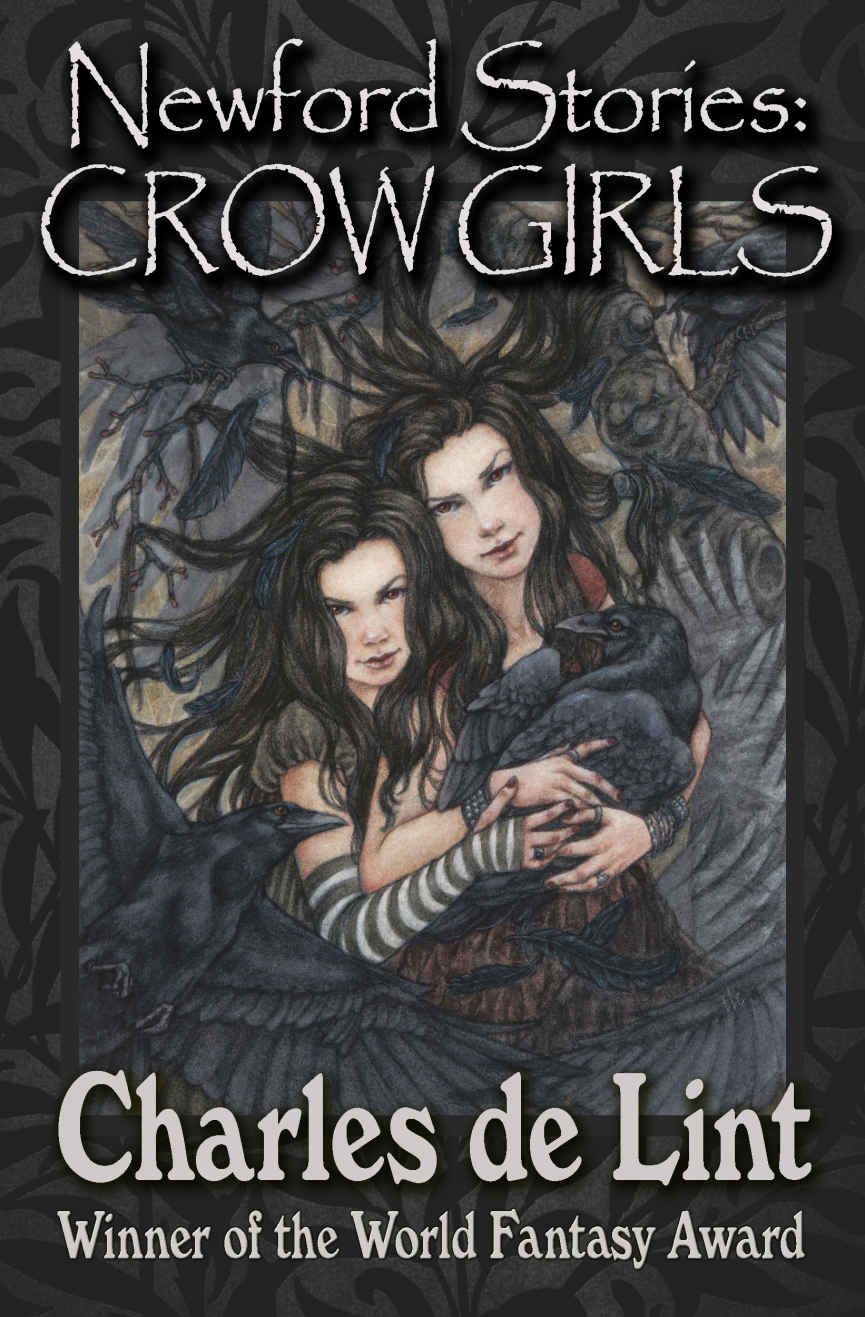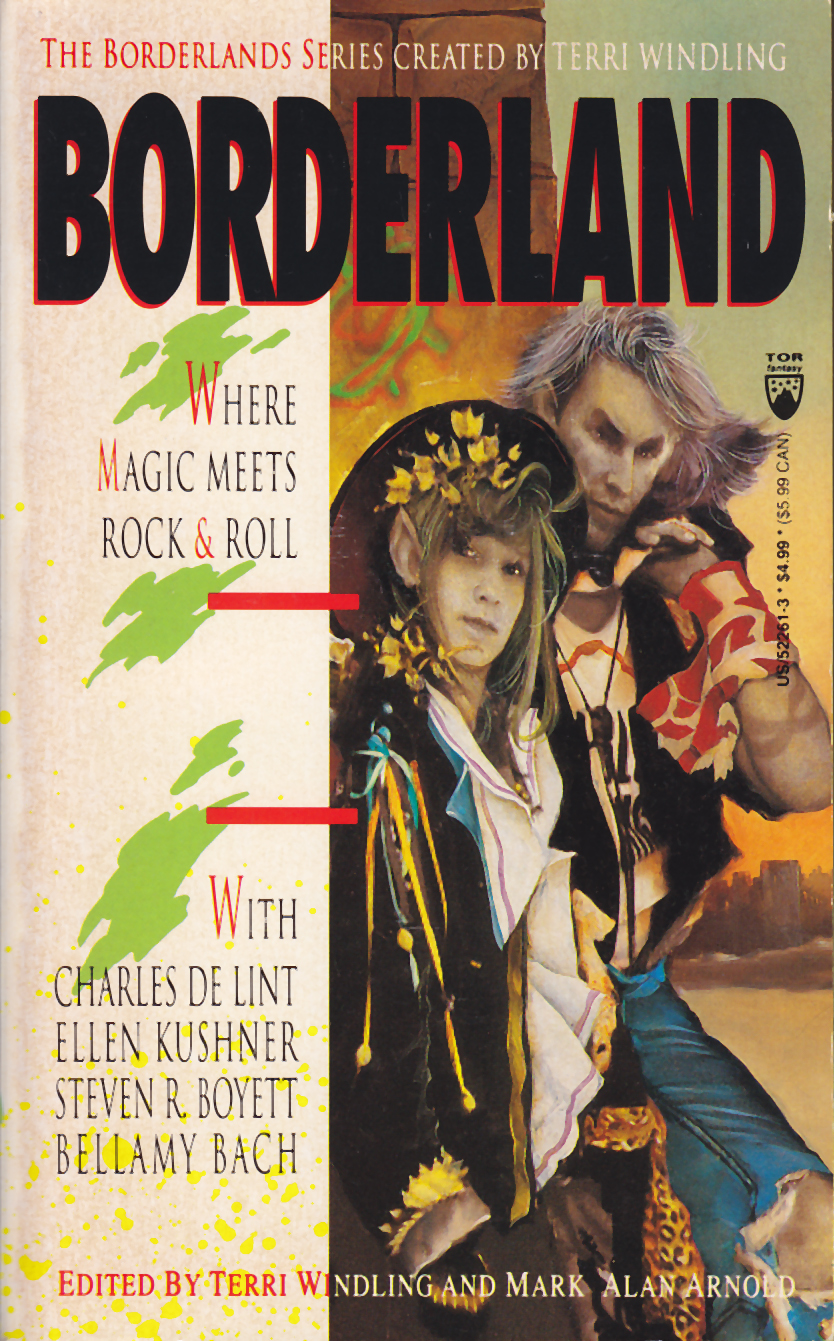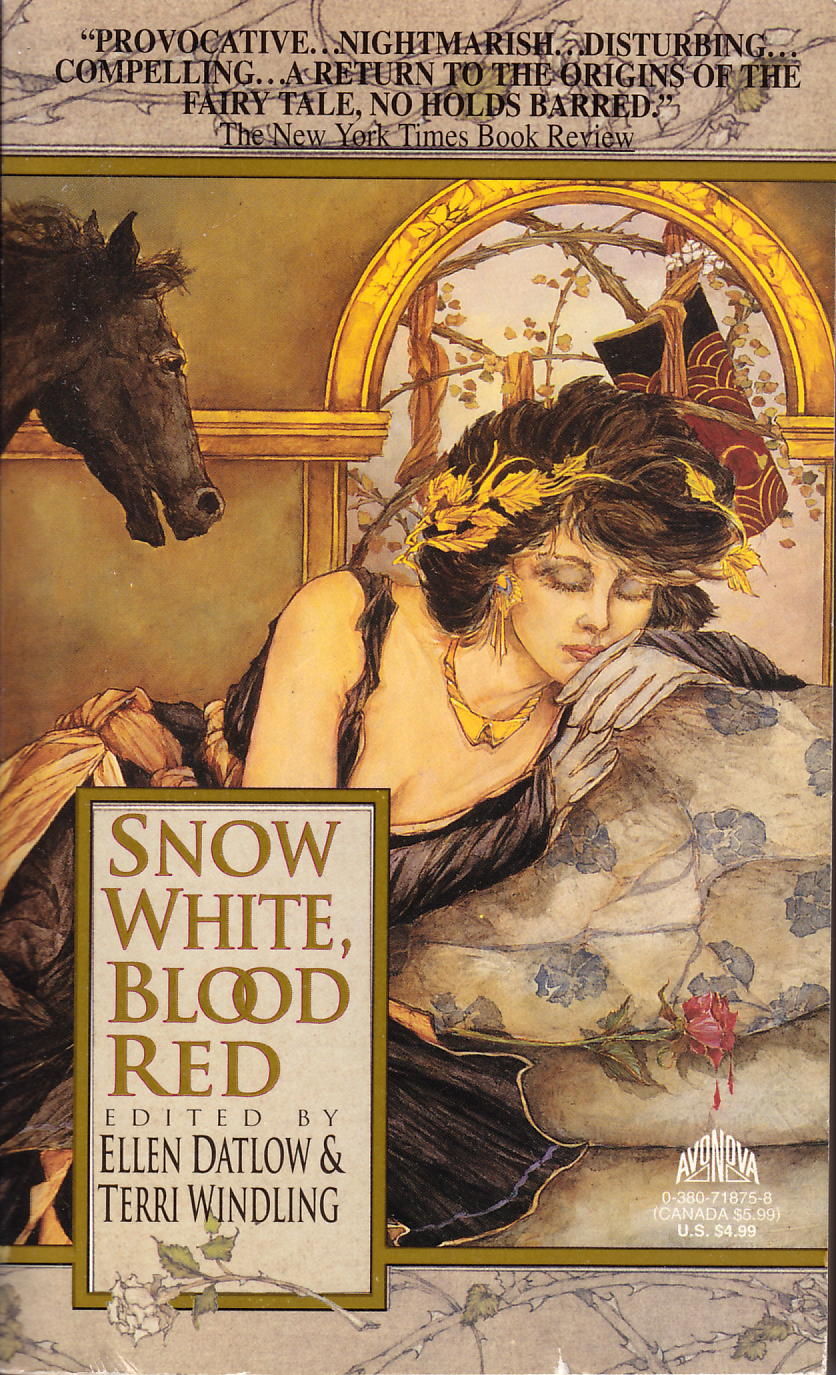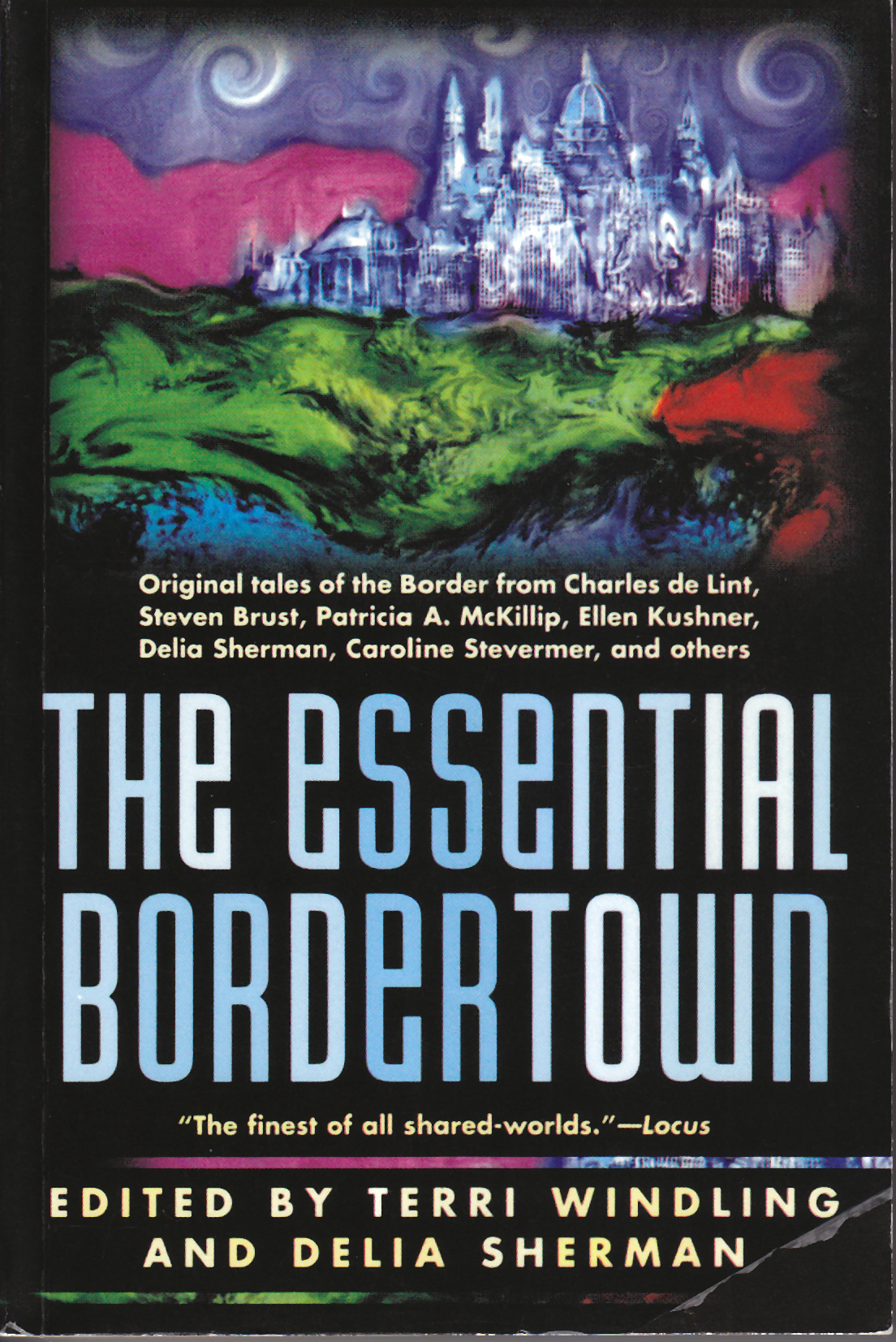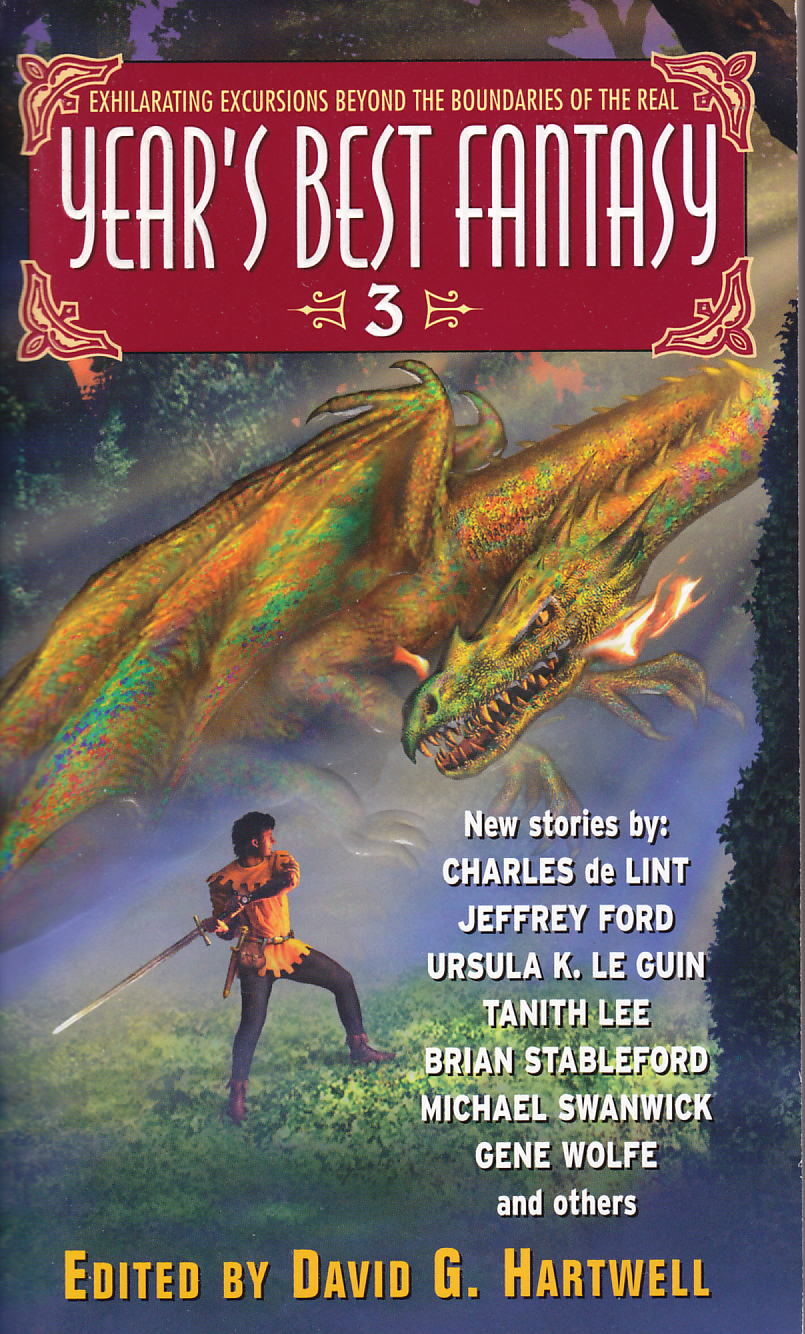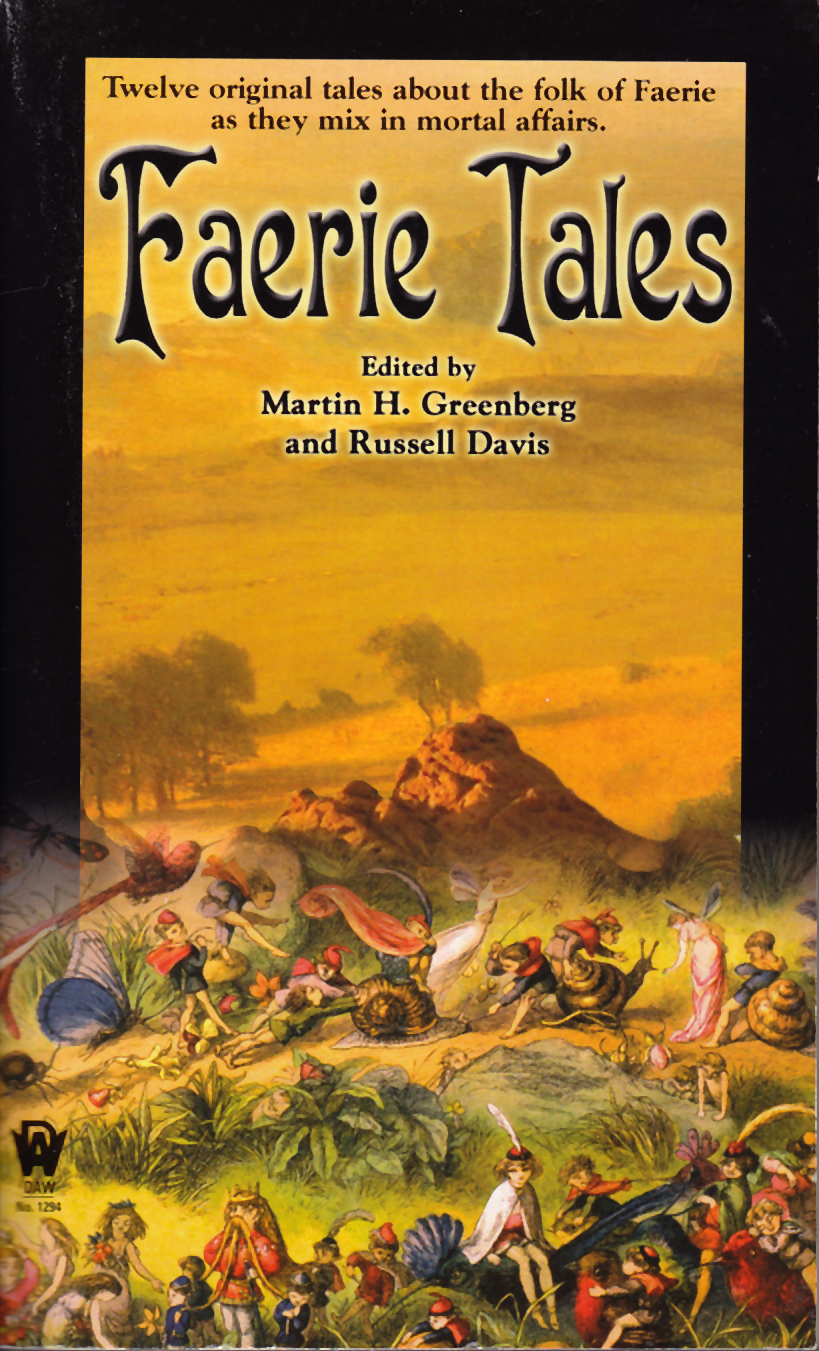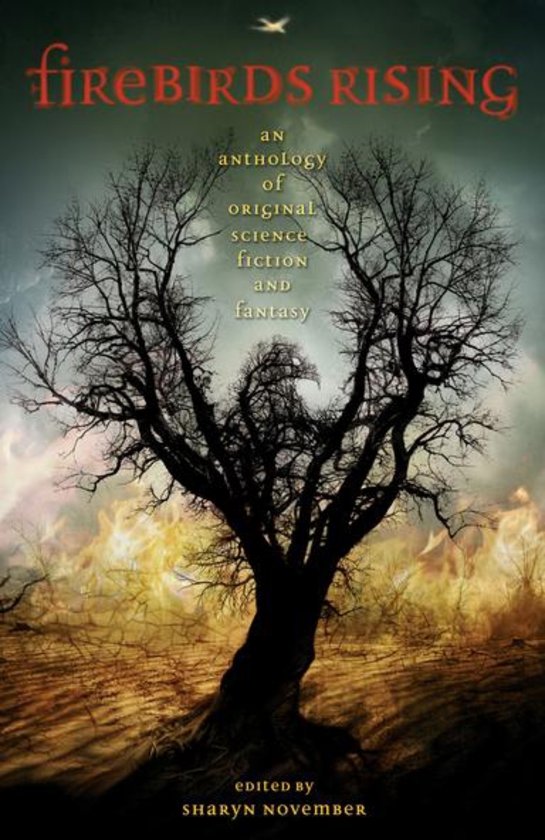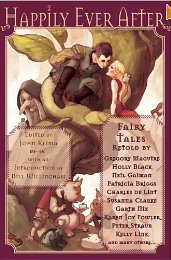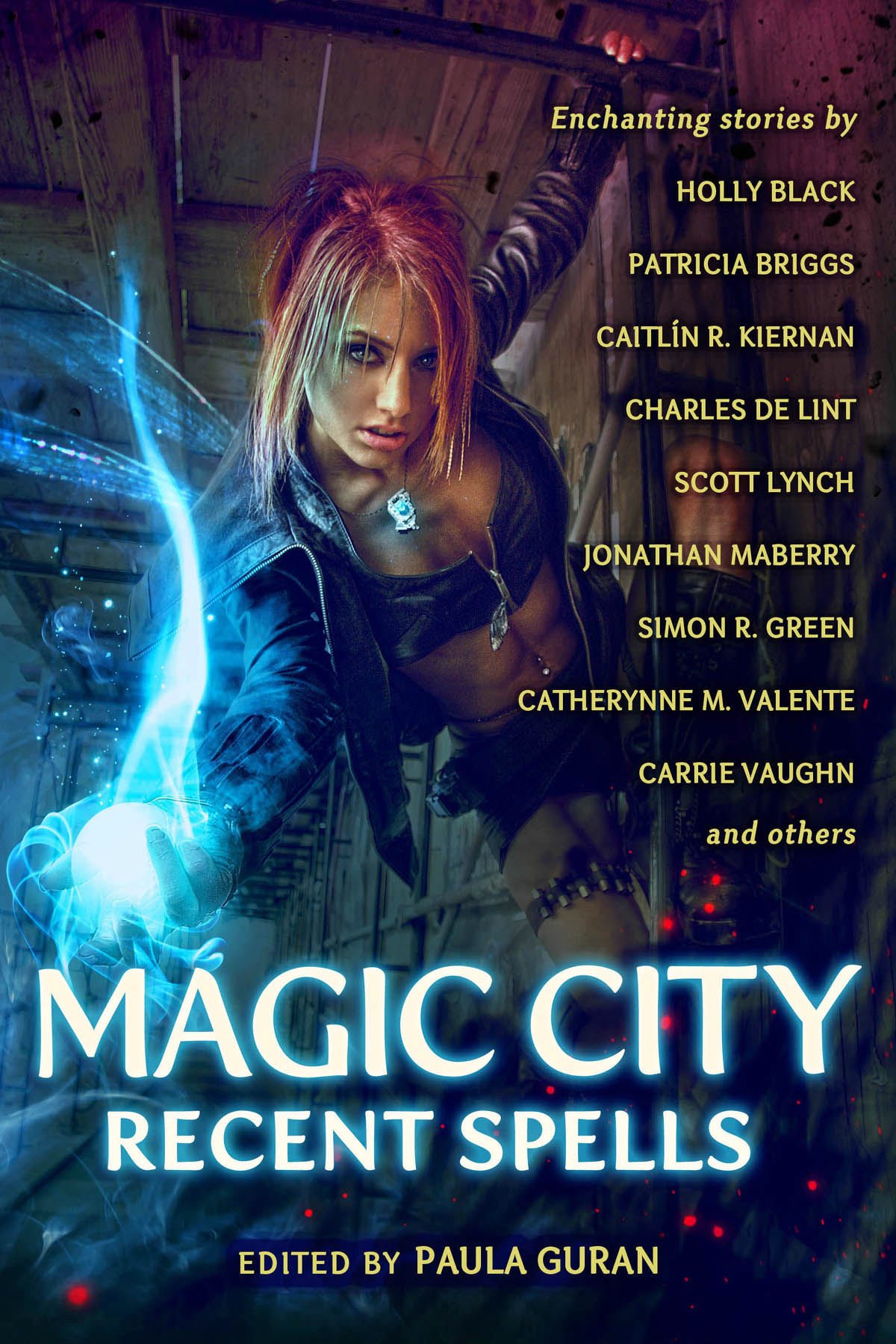Charles de Lint
Books: Fantasy | YA | Children's
The Harp of the Gray Rose (1985), Jack the Giant-Killer (1987), Wolf Moon (1988), Drink Down the Moon (1990), The Dreaming Place (1990), The Little Country (1991), The Wild Wood (1994), Seven Wild Sisters (2002), The Blue Girl (2004), Little (Grrl) Lost (2007), Old Man Crow (2007), Dingo (2008)
Newford: Dreams Underfoot (1993), Into the Green (1993), Memory & Dream (1994), The Ivory and the Horn (1995), Someplace to Be Flying (1998), Moonlight & Vines (1999), Forests of the Heart (2001), Tapping the Dream Tree (2002), The Onion Girl (2002), Waifs and Strays (2002), Spirits in the Wires (2003), Widdershins (2006), Companions to the Moon (2007), Promises to Keep (2007), Muse and Reverie (2009), The Very Best of Charles de Lint (2010), Newford Stories: Crow Girls (2015)
Snow White, Blood Red (1993), The Year's Best Fantasy and Horror: Seventh Annual Collection (1994), The Year's Best Fantasy & Horror: Eighth Annual Collection (1995), Excalibur (1995), The Essential Bordertown (1998),Year's Best Fantasy (2001), The Green Man: Tales from the Mythic Forest (2002), Year's Best Fantasy 2 (2002), The Faery Reel: Tales from the Twilight Realm (2004), Faerie Tales (2004), Emerald Magic (2004), Maiden, Matron, Crone (2005), Firebirds Rising (2006), The Coyote Road: Trickster Tales (2007), Vampires: The Recent Undead (2010), The Very Best of Charles de Lint (2010), Happily Ever After (2011), Under My Hat: Tales from the Cauldron (2012), Magic City: Recent Spells (2014), Street Magicks (2016)
Kids Books
A Circle of Cats (2003)
As far as I am concerned, Charles de Lint is the master of urban fantasy; he combines modern cityscapes with elements of folk and fairy tales. His novels and short story anthologies are set in Newford, which may or may not be Canada. The characters do recur from book to book, and you can start at any point, but there is some character development from book to book, so it may be more satisfying to read from the older books to the news ones.
Jack of Kinrowan: Jack the Giant-Killer (1987) & Drink Down the Moon (1990)
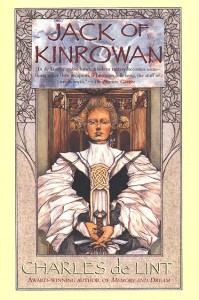 Jack of Kinrowan is actually two books, that were later published as a single compendium: Jack the Giant-Killer and Drink Down the Moon. I'll write about them separately, as they're two separate books, published three years apart, even though you can only find Jack of Kinrowan to purchase anymore.
Jack of Kinrowan is actually two books, that were later published as a single compendium: Jack the Giant-Killer and Drink Down the Moon. I'll write about them separately, as they're two separate books, published three years apart, even though you can only find Jack of Kinrowan to purchase anymore.
In Jack the Giant Killer, the Seelie Laird of Kinrowan's daughter has been stolen by the Unseelie Court, despite the fact that she was being escorted by the Gruagagh. And the Unseelie Court also has the Horn that controls the Hunt, so the Gruagagh--even if he were still trusted by the Laird's court--is trapped in his tower and unable to help, while no one else has the power to help. Except, maybe, a Jack.
Jacky Rowan has just been dumped. After an argument, her boyfriend has walked out the door, and even if he returned, she doesn't want him back. What she does want is to figure out what's wrong with her–what was missing. So she goes out to get roaring drunk, and discovers that faerie isn't a myth, and that most of the beings there aren't very nice, when she sees a tiny man–a hob she later discovers–murdered by a group of dark bikers.
There are a couple things about this story, first of which is that one single song placed the story VERY firmly in time.
Leaning forward, she turned on Judith's radio, switching stations until one came on playing the Montreal group Luba's latest single, "Let It Go."
However, aside from that single reference to a song from 1984 (and I suppose the lack of cell phones), like most of Charles de Lint's books, the rest of the story could have taken place at any time, because it is the elements of faerie that suck you into the story.
As I said, this isn't the happy fairy land of Tinkerbell and sexy elves.
"The time of darkness has come to our world–to Faerie… (H)ere the Unseelie Court grows stronger than ever before. Would you know why? Because your kind will always believe in evil before it believes in good. There are so many of you in this land, so many feeding the darkness…"
But let me be clear, this story isn't a dark trudge. Bad things happen, but with all of Charles de Lint's stories, somehow, even in the worst parts, the hope shines through.
The map was of Ottawa, but all the names were changed. Parliament Hill was the Laird's Manor and Court. The Market area was the Easting Fair. The Glebe became Cockle Tom's Garve.
There's few that believe in the Lairdsfolk, that's too true, but the Host … I've seen the books you read, the movies you see. They speak of the undead and of every horror that ever served in Gyre the Elder's Court. Your people might not say they believe when you ask them, but just their reading those books, watching those movies … Jacky Rowan, every time they do, they strengthen our enemy and make us weak.
I really like Jacky and Kate. I can understand Jacky's coming undone when her boyfriend walks out on her, and I really like how Kate sticks with her, even when she's not so sure that Jacky hasn't gone over the edge.
I also particularly liked the Hunt as they appeared in Jack the Giant Killer, as well as the way that Jacky deals with them. Maybe because for me it has echoes of Good Omens.
In Drink Down the Moon, Johnny Faw, after the death of his grandfather, goes out Vincent Massey Park to play "The King of the Fairies," which his grandfather made him promise to do. There he meets the Pook of Puxill, although he doesn't know who she is at the time. While the Pook has her own problems, because someone has been stealing the luck of the rade. For something is happening to the fiaina.
This book is very different from his short stories. Although the idea remains the same--that faerie is real, and coexists alongside our world--much of the story actually takes place in faerie, and the characters wander in and out of faerie at need and will. So there is a very different feel than in his short stories and books that take place in Newford, where the focus tends to be far more on the "real world" and "regular" people. Additionally, faerie characters are far more common in this book--pooks and hobs and boggles and trows.
As with all of Charles de Lint's books, the writing and storytelling are excellent. The second book seem a little different from the first book. Perhaps in pacing, perhaps because the focus of the second story is split between Jacky & Kate and Johnny and Henk. On the down side Henk seems a little flat to me, but it may have been that I wanted to get back about Jacky and Kate. And as always, there is a lot of music, with musicians and songs appearing throughout.
I must admit that love the cover of this book, despite the fact that there is no reason at all for the woman to be holding a sword. (I don't think there are any swords in this book.) But it's so gorgeous I just don't care. I'm not sure what it is that I like so much about Thomas Canty's fantasy covers, but I've seen very few that I haven't adored.
If you have not read Charles de Lint, this is an excellent first book to read, although you need to be aware that this is quite different from his short story collections. Just as good, but in a somehow different way. But underlying both is Charles de Lint's always excellent storytelling.
Cover by Thomas Canty.
Published by Orb
- March 2006 | Rating: 9/10
- October 2013 | Rating: 8/10
- August 2016 | Rating: 7.5/10
Wolf Moon (1988)
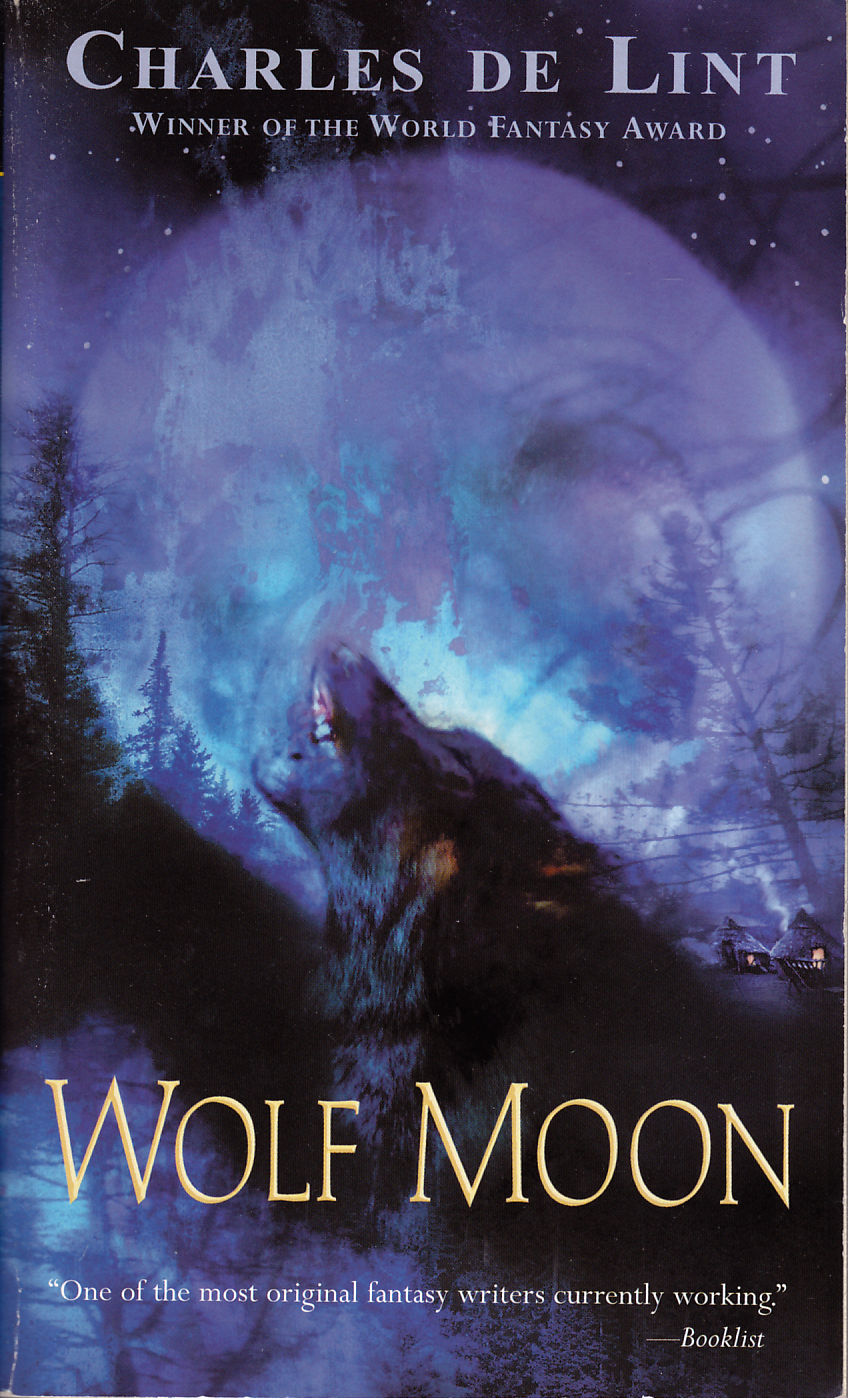 Wolf Moon is one of Charles de Lint's earlier books. It's quite short–only 245 pages. In tone, it reminds me very much of The Harp of the Grey Rose. A fantasy world that similar to, but not quite the same as, ours.
Wolf Moon is one of Charles de Lint's earlier books. It's quite short–only 245 pages. In tone, it reminds me very much of The Harp of the Grey Rose. A fantasy world that similar to, but not quite the same as, ours.
Kern is a werewolf. Accepted by neither humans or wolves, and afraid of being slain by any humans who discover what he is, he has come to accept his fate, until he is hunted by a magical harper, and nearly slain by the harper's mythical beast.
Oddly enough, it is neither Kern not Ainsey I like the best by the end of the tale, but Fion. When she acts, she does so out of loyalty and love. Self-preservation seems to take second place to helping those she loves. And considering that she initially comes across as someone self-absorbed and interested only in pleasure, this discovery of her depths was all the more enjoyable.
But I have to admit that as much as I love Charles de Lint's urban fantasy, I may like his traditional fantasy, but I simply do not find it anywhere near as compelling. The characters don't seem quite as real as the inhabitants of Newford, although I couldn't possibly tell you why this is so.
If you like Charles de Lint, then you will almost certainly want to read Wolf Moon, especially if you liked The Harp and of Grey Rose. If you have not read any of Charles de Lints books before, I would recommend that you start somewhere else, because although I enjoyed this story, I didn't find it anywhere near as good as his other works, especially his short story collections. It may also be that I have very high expectations for Charles de Lint's writing, and although this is a good story, I don't think it is anywhere close to as good as any of his Newford books and collections.
Cover by Cliff Nielsen
Firebird
August 2006 | Rating: 6/10
The Dreaming Place (1990)
 This is a very short book--only 138 pages, in my version--I picked it up used at the Bookshelf, but it has apparently been re-released). It's interesting.
This is a very short book--only 138 pages, in my version--I picked it up used at the Bookshelf, but it has apparently been re-released). It's interesting.
The protagonists are high school girls, and the peripheral characters are his typical assortment of people with whom most of us don't normally associate i.e. street people and shaman (is that plural and singular) and mystics, which is okay, because I don't want to read books about the people with whom I normally associate. That's be fiction, not fantasy (and probably painfully boring at that.)
I like what he did with his characters, and I loved the story, although I wonder if this might have been better had it been a long story in a collection instead of a short book. (I realize there is barely a difference there, but this book (earlier than other books and collections I have) seemed somehow a little different from his other stories I have read, though I don't think I can place my finger on it.
So I think in sum this is a good book, and if you are a fan of Charles de Lint this should be added to your collection, but if you are looking for a first book by him, I'm not sure this is it.
The Little Country (1991)
 While musing over a broken relationship that may lead to a broken tour of American, Janey searches the attic and finds a book by her favorite author–an author who was good friends with her grandfather–and discovers there was only a single copy of the book printed, and that her grandfather was requested to hide the book and keep it safe. From there we read not only Janey's story, but the story in the book she has discovered in her grandfather's attic.
While musing over a broken relationship that may lead to a broken tour of American, Janey searches the attic and finds a book by her favorite author–an author who was good friends with her grandfather–and discovers there was only a single copy of the book printed, and that her grandfather was requested to hide the book and keep it safe. From there we read not only Janey's story, but the story in the book she has discovered in her grandfather's attic.
Yesterday I must have picked up half a dozen book, read the first couple of paragraphs, and then put them back down with the thought, "this isn't what I'm in the mood for."
So I picked up The Little Country, because it was by Charles de Lint, so how could I go wrong?
Unfortunately, after reading the last page, I put the book down thinking, "well, that wasn't what I was in the mood for either."
I just could not get into this book. Probably the best way to describe it is that it was just entirely too long.
One problem was that point of view skipped around too much--and by this I don't mean between the two stories. I liked the idea of a book within a book. But in the "main" story, the point of view kept shifting from Janey to everyone around her, be they good guys or bad guys or not so sure where they stand guys. So I never felt like I developed a relationship with the characters, either through their own thoughts and feelings, or through how Janey felt about them.
Another thing is that there was just entirely too much detail that simply struck me as unimportant. Like I said, the book just felt like it went on far longer than it needed to, and I might have liked it better had it been far shorter.
In general, the whole thing just felt off to me.
So, if you have not read Charles de Lint before, I do not recommend starting here. There are plenty of other excellent books and short story collections available--leave this one for after you've read everything else.
Cover by Dave Henderson
Orb
August 2006 | Rating: 5/10
The Blue Girl (2004)
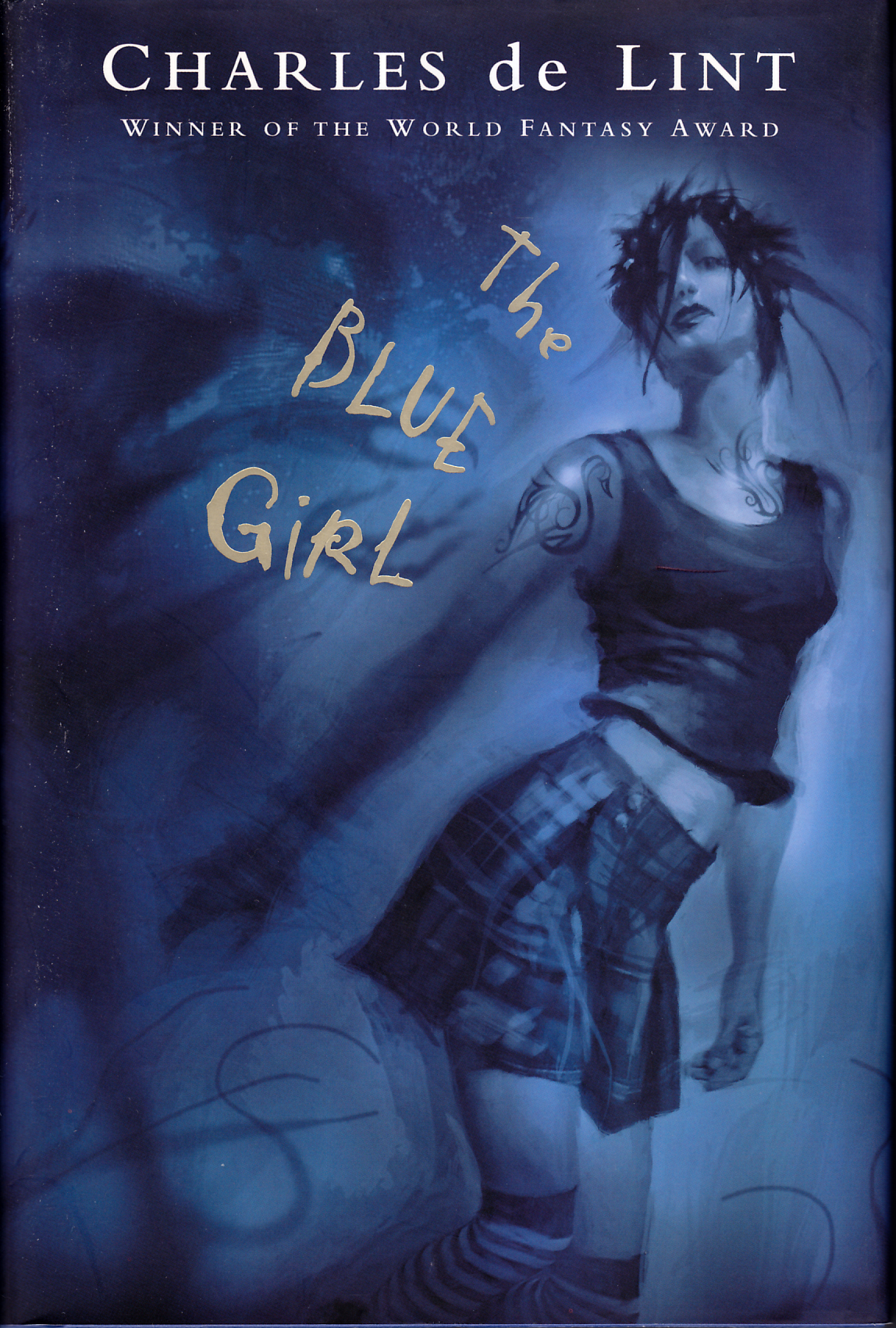 I love Charles de Lint. There is nothing he has written that I have read that I have not liked, and most of what he writes I absolutely love. Yet for some reason I was hesitant to read this book. Probably because the main characters are high school students. As usual, as soon as I started the book I wondered what I had been worried about, because as always, Charles de Lint has written an excellent book.Imogene's family has moved to Newford, and she decides to take advantage of the move to a place where no one knows her, to change herself, and to stay out of trouble. On the first day of school she makes friends with Maxine, a girl outcast from her peers for being smart, and that friendship immediately puts her on the outs with the popular kids.
I love Charles de Lint. There is nothing he has written that I have read that I have not liked, and most of what he writes I absolutely love. Yet for some reason I was hesitant to read this book. Probably because the main characters are high school students. As usual, as soon as I started the book I wondered what I had been worried about, because as always, Charles de Lint has written an excellent book.Imogene's family has moved to Newford, and she decides to take advantage of the move to a place where no one knows her, to change herself, and to stay out of trouble. On the first day of school she makes friends with Maxine, a girl outcast from her peers for being smart, and that friendship immediately puts her on the outs with the popular kids.
And she meets Ghost. A boy who died at school under mysterious circumstances--was it murder or suicide or accident.
As always, Charles de Lint does an excellent job of showing the internal lives of his teenage characters, which moves them from the annoying, angst-ridden creatures that other authors create, to people that I can remember being as a teen.
The bullying was pretty rough in this book, and brought back some unpleasant memories, although it made me realize how lucky I was that the bullying I dealt with as a teenager was never physical. (Although I hardly felt luck at the time.)
But the bullying is not the focus of the story, just a bit that added to the realism of his description of high school. The focus is instead on the fact that Newford, is closer to faerie than other places in the real world. Several of the characters who lives in Newford are mentioned, and some make brief appearances, but for the most part the book is about Imogene and Maxine and Ghost.
I really like Imogene. She's smart and resourceful, but Charles de Lint also shows that whatever the image she projects, she has doubts and fears. She worries that her past will horrify Maxine and ruin our friendship. This is, at least for those of us willing to admit it, a common fear--that if people find out what we're really like, they will be so disgusted they will no longer love us. She's very real, and very likable.
The Blue Girl has teenage characters, and is listed as a young adult book, but like Waifs and Strays is completely accessible to anyone who remembers what it was like to be a teenager. So if you like Charles de Lint's writing, this is a book you don't want to miss. If you've never read one of his books before, this would be a fine place to start.
Cover by Cliff Nielsen
Firebird
August 2005 | Rating: 8/10
Little (Grrl) Lost (2007)
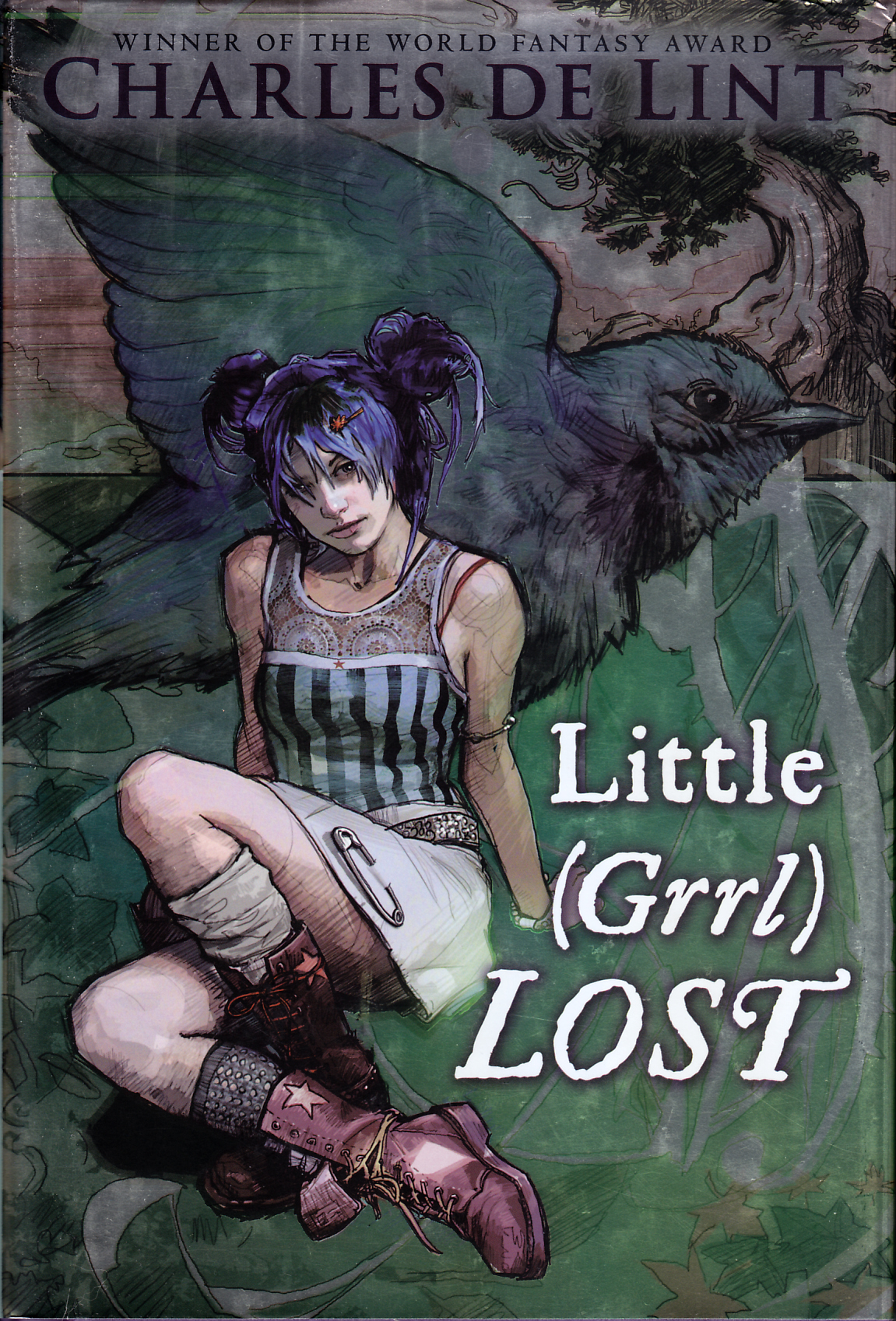 I'm a huge fan of Charles de Lint, and own most of his book. But when I get a new book of his, I'll put off reading it for awhile, for some unknown reason. Then later I'll come upon the book and remember I had it, snatch it up, and read it.
I'm a huge fan of Charles de Lint, and own most of his book. But when I get a new book of his, I'll put off reading it for awhile, for some unknown reason. Then later I'll come upon the book and remember I had it, snatch it up, and read it.
I've been out of sorts recently, and none of the books I've started reading have interested me. What I often do on this occasion is pick up an anthology of short stories, in this case, Firebirds Rising: An Anthology of Original Science Fiction and Fantasy. Once I started reading Charles de Lint's story, I realized that it had been expanded into a novella, which I had. So the next day I picked up the novella Little (Grrl) Lost and started reading where the short story had left off.
T.J. is fourteen and hates living in the city. She was happy living on the farm, and didn't want to move, no matter how much she understood that her parents had no choice. Elizabeth wants to see more of the world, but her status as a Little greatly restricts her life. Despite their differences, they end up becoming friends.
How's that for a synopsis? Not that impressive, I know, but it's hard to describe a Charles de Lint story without giving away the most interesting parts.
So if you have not read Charles de Lint, what should you expect? First, he is very good at writing teen characters. The teens in his books have problem and issues, but they deal with those issues the way real teens would: sometimes foolishly, but with the best of intentions, and they learn from their mistakes.
Next, as with many of his books, the story is set in and around Newford (even though I don't believe this is ever explicitly stated) and you catch glimpses of characters from other stories.
One thing I particularly liked about this story was that when the situation TJ is in explodes, no one actually did anything wrong–the steps everyone takes are logical, and make sense; it's simply that events mean different things to different people.
But I think that the characters are the heart of Charles de Lint's stories. You care about the characters and what happens to them, because they feel like real people who make real mistakes. You can understand their troubles and problems, and even if you would not choose the path they did, you understand their path.
If you have not read Charles de Lint, then you could certainly begin here without difficulty–no understanding of Newford or other characters is necessary. Although TJ makes some decisions that might make parents uncomfortable, this would still be a good book for younger teens, and one I can heartily recommend.
Cover by Scott M. Fischer
Firebird
December 2009 | Rating: 8/10
Dingo (2008)
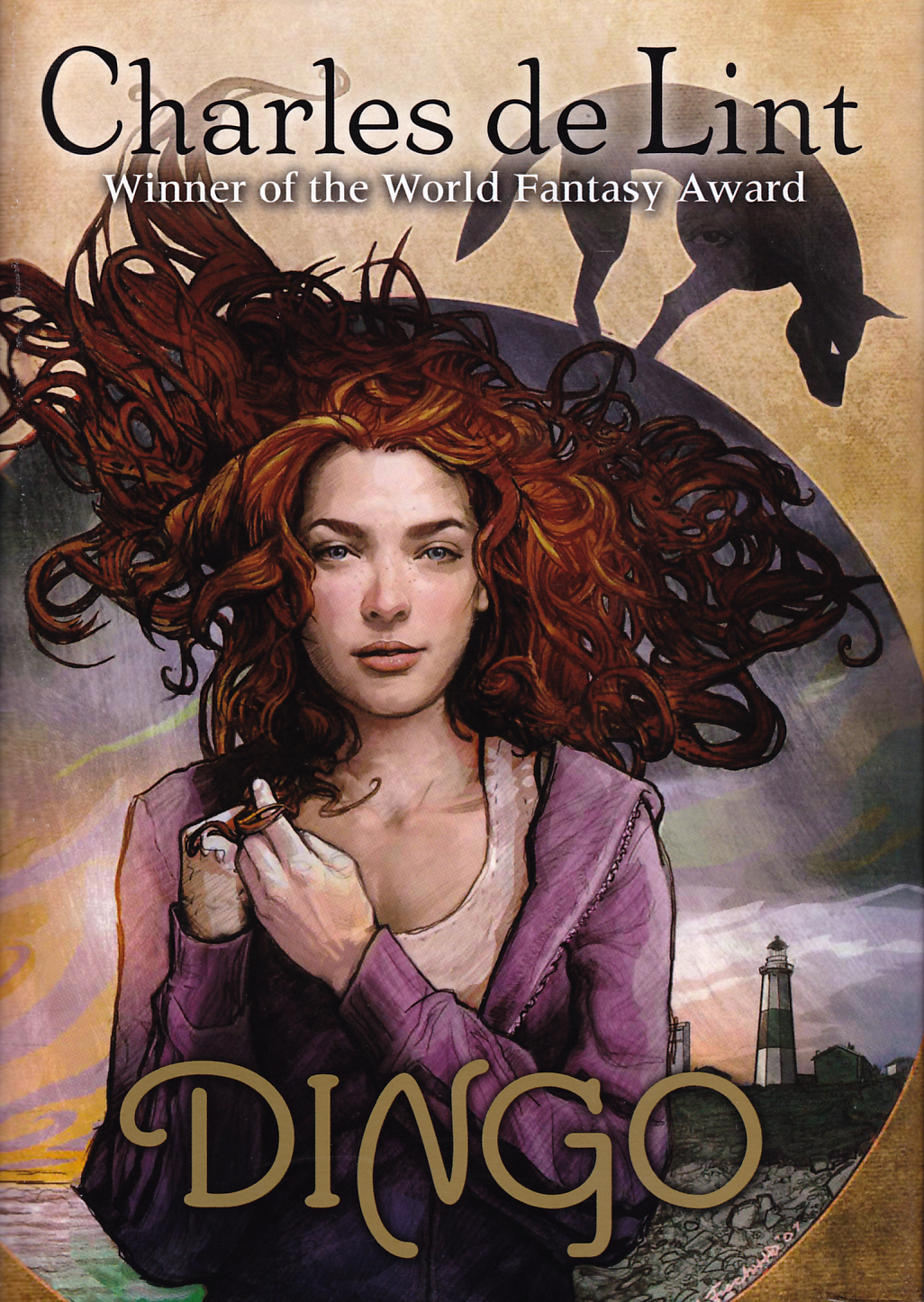 This is another of Charles de Lint's young adult stories–the characters are teenagers, though the setting is of course the secret magical world just beyond the sight of most of us.
This is another of Charles de Lint's young adult stories–the characters are teenagers, though the setting is of course the secret magical world just beyond the sight of most of us.
Unfortunately, unlike most of his books, I found Dingo disappointing. Interestingly, I found myself surprised to discover the main character was male. As far as I can recall, most of his young adult books have female lead characters, and the red-headed girl on the cover also led me to assume the main character would be female. I have no idea is that is part of the reason the story didn't work that well for me, after all, he's written plenty of male characters in the past (even if the majority of his characters are female).
So what went wrong with this story? First, although I wanted to know what happened, it just didn't draw me in the way his stories normally do, though I can't precisely say why.
Second, I though the two boys were entirely two accepting of the faerie world they discover. These aren't young boys, but are supposed to be 17 year-old high school seniors. Instead, they felt much younger, and acted in ways that just felt off to me. And although Miguel was the main character, I found Johnny to be far more interesting.
Although his book wasn't horrible, it was very disappointing for a Charles de Lint book, and I can't really recommend it if you're expecting his usual quality.
Strangely, I think I would have rated this book higher if it had been written by someone else, however, I have high expectations for Charles de Lint, so this was a definite disappointment.
Cover by Scott M. Fischer
Published by Firebird
February 2012 | Rating: 5/10
Dreams Underfoot (1993)
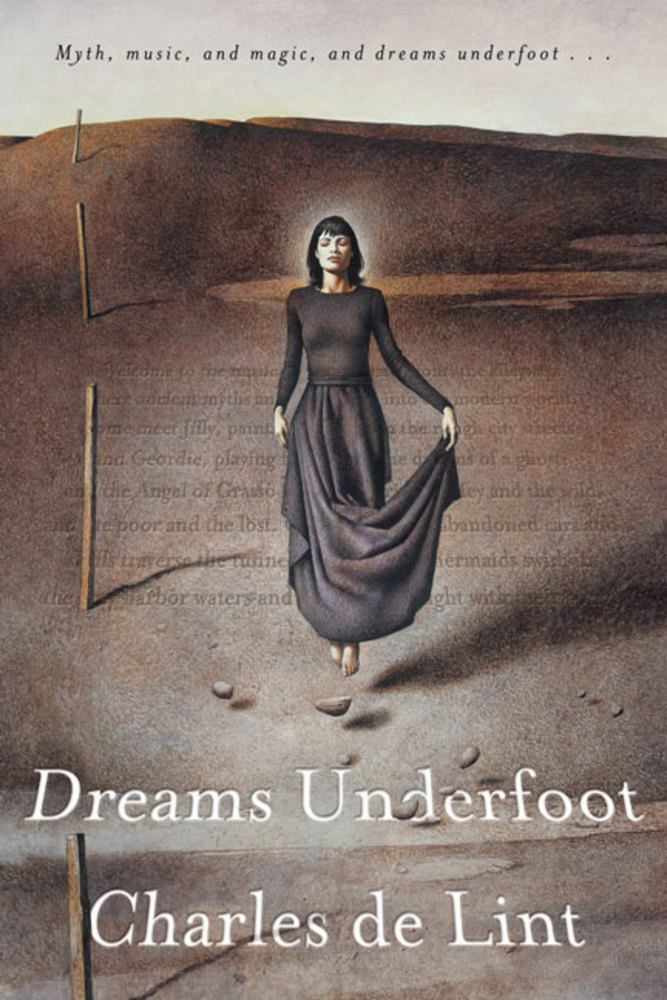 I believe that Dreams Underfoot is the first Charles de Lint book I bought. I may have read one of his stories somewhere (Now that I look, I may have first read "The Moon Is Drowning as I Sleep" in Snow White, Blood Red, and from there been sucked in.), perhaps in a "Year's Best in Fantasy and Horror." Or I may have just seen the cover and snatched up the book.
I believe that Dreams Underfoot is the first Charles de Lint book I bought. I may have read one of his stories somewhere (Now that I look, I may have first read "The Moon Is Drowning as I Sleep" in Snow White, Blood Red, and from there been sucked in.), perhaps in a "Year's Best in Fantasy and Horror." Or I may have just seen the cover and snatched up the book.
- "Uncle Dobbin's Parrot Fair," Isaac Asimov's Science Fiction Magazine, Nov ‘87
- "Stone Drum," Triskell Press chapbook, 1989
- "Timeskip," Post Mortem: New Tales of Ghastly Horror, ed. Paul F. Olson & David B. Silva, St. Martin's, 1989
- "Freewheeling," Pulphouse: The Hardback Magazine Issue 6, ed. Kristine Kathryn Rusch, Pulphouse, 1990
- "That Explains Poland," Pulphouse: The Hardback Magazine Issue 2, ed. Kristine Kathryn Rusch, Pulphouse, 1988
- "Romano Drom," Pulphouse: The Hardback Magazine Issue 5, ed. Kristine Kathryn Rusch, Pulphouse, 1989
- "The Sacred Fire," Stalkers, ed. Ed Gorman & Martin H. Greenberg, Arlington Heights, IL: Dark Harvest, 1989
- "Winter Was Hard," Pulphouse: The Hardback Magazine Issue 10, ed. Kristine Kathryn Rusch, Pulphouse, 1991
- "Pity the Monsters," The Ultimate Frankenstein, ed. Byron Preiss, David Kellor, Megan Miller & John Gregory Betancourt, Dell, 1991
- "Ghosts of Wind and Shadow," Triskell Press chapbook, 1990
- "The Conjure Man," After the King, ed. Martin H. Greenberg, Tor, 1992
- "Small Deaths," original to the collection
- "The Moon Is Drowning While I Sleep," Snow White, Blood Red, ed. Ellen Datlow & Terri Windling, AvoNova, 1993
- "In the House of My Enemy," original to the collection
- "But for the Grace Go I," Chilled to the Bone, ed. Robert T. Garcia, Mayfair Games, 1991
- "Bridges," The Magazine of Fantasy & Science Fiction, Oct/ Nov ‘92
- "Our Lady of the Harbour," Axolotl Press: Eugene, OR, 1991
- "Paperjack," Cheap Street: New Castle, VA, 1991
- "Tallulah," Dead End: City Limits, ed. Paul F. Olson & David B. Silva, St. Martin's, 1991
I have to say that I love the original cover, with the art by Terri Windling. The white haired woman with horns and a wooden flute sprouting leaves. The cityscape in the background. For me, it is just completely evocative of Charles de Lint's writing. Not that there's anything wrong with the new cover, but it's just so much more sparse and barren.
 Here. Look.
Here. Look.
Isn't that lovely?
But this isn't suppose to be about the covers, this is supposed to be about the writing, about the book that got me started reading Charles de Lint, now one of my top five favorite authors.
Dreams Underfoot is a short story collection, and almost all the stories are set in Newford, the mythical northern town, where the seams of the world between the mundane and the magical are thinner than they are elsewhere.
Dreams Underfoot is the introduction to many of the characters who populate Charles de Lint's later stories and books: Jilly Coppercorn, Sophie Etoile, Geordie and Christie Riddell, Meran and Cerin Kelledy, the Angel of Grasso street, Maisie and Tommy. These are characters you'll meet again, some of whom get their own books, some of whom drop from sight, appearing later only in passing.
The stories are urban fantasy, where the magical exists in our own time and place, alongside the reality we know, although the characters may deny their experiences.
Interestingly, these stories are always darker than I remember, although this collection may have a higher percentage of horror than other collections, as several stories, such as "The Sacred Fire" and "Pity the Monsters" are straight horror, while other stories have very darker elements and themes. But don't let that scare you away, because this is a wonderful collection, and an introduction to many characters that appear throughout Charles de Lint's work. And although I am not a fan of horror (I'm one of those strange people who doesn't like being scared), I do not find the horror particularly hard to read. It's not my favorite, but it's good.
And the darker stories may be horrifying in a different way, yet they are still excellent, not only in the way the develop the characters, but simply in their storytelling. Despite the upsetting nature of "In the House of My Enemy," it is still an excellent story, and one that I couldn't keep myself from rereading, despite knowing the darkness of the content.
But there are also plenty of stories that aren't dark. I particularly liked "Romano Drom", "The Moon is Drowning while I Sleep", and "Paperjack", although they are more upbeat than some of the other in this collection. (If you find the end of "Timeskip" depressing, you'll probably like "Paperjack".)
There is simply something about Charles de Lint's storytelling that I find irresistible. it never fails to amaze me, how he can weave an entire tale in so few words. He is the reason why I find so many short story collections disappointing, for he has set the bar to which all others must rise.
There are also stories here that have appeared in other collections, such as "Uncle Dobbin's Parrot Fair," which I believe may be slightly different here than it appeared elsewhere.
I am extremely curious, however, as to how much of Christie Riddell there is in Charles de Lint, and whether Christie's ideas about writing and short stories are Charles de Lint's, or if they are just part of that character.
"Uncle Dobbin's Parrot Fair" isn't set in Newford, but it doesn't not fit in this anthology.
Ellen carried a piece of string in her pocket, with four complicated knots tied into it, but no matter how often she undid one, she still had to wait for her winds like anyone else. She knew that strings to catch and call up the wind were only real in stories, but she liked thinking that maybe, just once, a bit of magic could tiptoe out of a tale and step into the real world.
Ellen has been searching for years for the magic she saw in her childhood. But there is darkness as well as beauty in magic.
"The Stone Drum" is the first Jilly story. I appreciate how our view of Jilly changes over the collection. Initially she's a pretty artist who wants to believe in magic.
"Religious artifacts and trappings require faith— a belief in their potency that the skookin undoubtedly don't have. The only thing I know for certain that they can't abide is the truth."
"Timeskip" is the first story in which Jilly and Geordie appear together. It's a love story and a ghost story and a story of heartbreak.
"Freewheeling" is another story of heatbreak, only it is the heartbreak commonly seen on the streets. It's another Jilly story, even if she isn't necessarily the primary character.
"That Explains Poland" is a story about a Latina character, but it's not a Latina story. It's a Bigfoot story.
Verdad, I still don't know who I am or where I fit in. I stand in front of the mirror and the muchacha I see studying me just as carefully as I'm studying her looks older. But I don't feel any different from when I was fifteen.
So when does it happen?
Maybe it never does.
Charles de Lint's stories are full of amazing women, and those women are not all white. Because that's the way the world is.
"Romano Drom" is a story of the secret roads that run through the world.
The road. The Chinese called it a dragon track. Alfred Watkins, in England, had discovered the old straight tracks there and called them leys. Secret ways, hidden roads. The Native Americans had them. African tribesmen and the aborigines of Australia. Even her own people had secret roads unknown to the non-Gypsy.
"The Sacred Fire" is an especially dark story, mostly because unlike many of his other stories, it doesn't end with any note of hope, only the possibility of more horror.
"Winter Was Hard" is another Jilly story, where we being to see her complexities, as she plans to spend Christmas with an elderly man in a nursing home, without family to go home to or visit, but it's also about magic and memory.
There were people who just made other people feel good. Just being around them, made you feel better, creative, uplifted, happy. Geordie said that she was like that herself, though Jilly wasn't so sure of that. She tried to be, but she was subject to the same bad moods as anybody else, the same impatience with stupidity and ignorance.
"Pity the Monsters" is another very dark story, that lacks the hope usually found in these stories. It's about the loneliness of monsters.
"Ghosts of Wind and Shadow" is a Meran and Cerin story, and also the story of a teenage girl whose mother doesn't understand the magic she sees in the world. It's also an explanation of sorts as to why people don't see or talk about magic in the world.
"The Conjure Man" is a story I particularly like, and the events here are referenced in later stories (although not in this book). It's about a tree of tales and memory.
(T)hat's our hope for the future, isn't it? That the imagination reaches beyond the present to glimpse not so much a sense of meaning in what lies all around us, but to let us simply see it in the first place?"
"Small Deaths" is the story of an overnight DJ, and the people who are drawn to her. The main character is a tiny bit like Kitty the werewolf, but only, really, because I think midnight DJs are a sort of their own.
"The Moon Is Drowning While I Sleep" is a Sophie Etoile story (Jilly makes an appearance). Sophie is another character who recurs throughout the series.
(D)reams want to be real. When you start to wake up, he said, they hang on and try to slip out into the waking world when you don't notice. Very strong dreams, he added, can almost do it; they can last for almost half a day, but not much longer.
"In the House of My Enemy" is probably the most heart-breaking story in the book. It's where we discover that Jilly is far more than we could have imagined, and that her love of her friends and the world in general is a miracle.
"But for the Grace Go I" is another story that I especially like and that has always stuck in my mind. A young woman has made her life on the streets, caring for those who can't care for themselves, wanting nothing more except to be left alone.
Except that life asks more of us.
"Bridges"
You build the bridge and it either takes you where you want it to, or it doesn't."
"And if it doesn't?" His teeth flashed in the moonlight. "
Then you build another one and maybe another one until one of them does."
"Our Lady of the Harbour" is The Little Mermaid, except it's more.
"Paperjack" is another story I particularly like. It picks up where "Timeskip" leaves off, with Geordie trying to come to terms with Sue's disappearance.
If I had to describe myself as belonging to any church or mystical order, it'd be one devoted to secular humanism. My concerns are for real people and the here and now; the possible existence of God, faeries, or some metaphysical Otherworld just doesn't fit into my worldview.
But the story also has Paperjack, who is a fascinating enigma.
Around him, an overcast day didn't seem half so gloomy, and when the sun shone, it always seemed brighter. He just exuded a glad feeling that you couldn't help but pick up on. So in that sense, he was magic.
"Talullah" is a Christy Riddell story. For some reason, he is the character I find least compelling in Newford.
(S)he taught me that getting close can hurt, but not getting close is an even lonelier hurt.
In some ways it's the flip-side to "Our Lady of the Harbour" but it's also the story of the city and of change.
If you love short stories, then any Charles de Lint collection is a must have, and Dreams Underfoot, with so many characters who recur in other stories, is a perfect introduction. However, as he is a master of writing short stories, you can start anywhere and be perfectly happy.
Cover by John Jude Palencar.
Publisher: Triskell Press
- February 2006 : Rating: 8/10
- June 2018 | Rating: 8.5/10
The Wild Wood (1994)
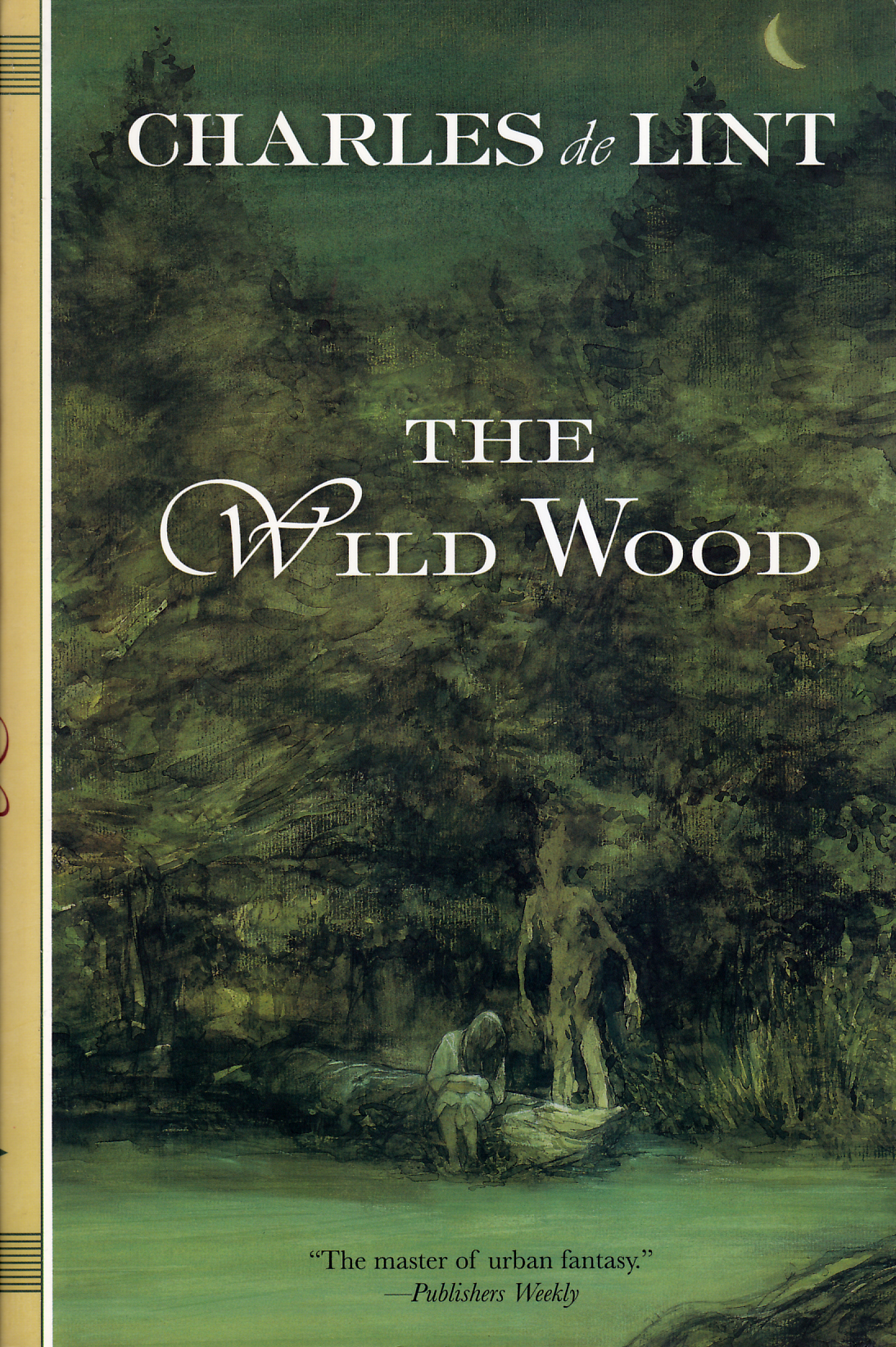 Eithnie feels like she has lost something in her paintings, and is wandering the woods near her home searching for the soul that used fill her paintings.Originally published in '94, Orb rereleased The Wild Wood in 2004. It's a very short book, just 205 pages with wide margins and so it only took me about two hours to read.
Eithnie feels like she has lost something in her paintings, and is wandering the woods near her home searching for the soul that used fill her paintings.Originally published in '94, Orb rereleased The Wild Wood in 2004. It's a very short book, just 205 pages with wide margins and so it only took me about two hours to read.
This is an okay book (it couldn't be bad--it is Charles de Lint after all) but it won't become one of my favorites. The parts that I like about his work are all there--the characters, the story, the otherworld--but for some reason it never really quite comes together for me. I never get drawn into the story the way I normally do with his writing. I was interested in what was happening, but I wasn't absorbed.
If you're a de Lint fan you'll want this book, but if you haven't read any of his previous books, I don't recommend this is a starting place. It's not his strongest work, and feels more like it belongs in one of his short story collections than as a novel. If you're looking to start reading Charles de Lint, I'd recommend Jack of Kinrowan or one of his short story collections like Dreams Underfoot or Moonlight and Vines.
Cover by by Stephen T. Johnson
Orb
August 2005 | Rating: 7/10
The Ivory and the Horn (1995)
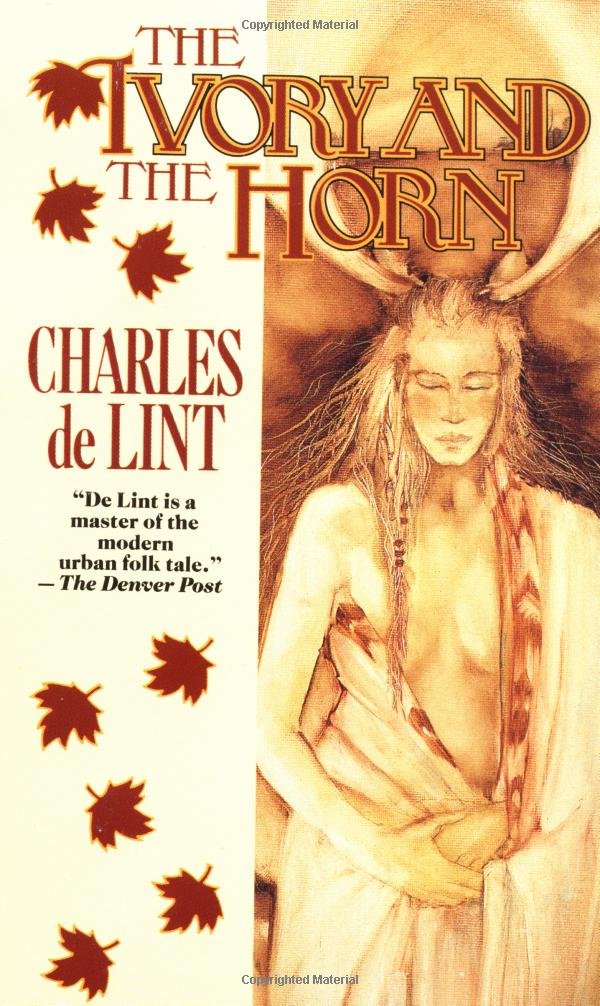 The Ivory and the Horn is the second short story collection by Charles de Lint, and like Dreams Underfoot, is set in Newford, the mythical North American city, where mythical beings reside.
The Ivory and the Horn is the second short story collection by Charles de Lint, and like Dreams Underfoot, is set in Newford, the mythical North American city, where mythical beings reside.
Reading these short stories makes me wish there there really was a Newford, so that I could move there. But if there was, and if I did, doing so would mean I was missing the point of his stories, which is to see the myth and beauty in the everyday world that surrounds us. But of course he puts it much more elegantly than that, like in this passage from "A Tempest in her Eyes."
"What bedevils you," he says, "is that you have misplaced the ability to see--to truly see behind the shadow, into the heart of the thing--and so you no longer think to look. And the more you do not look, the less you are able to see. Wait long enough and you'll wander the world as one blind."
I love mythology and folk tales, so how could I not but love Charles de Lint's stories. Yet what is so wonderful about his tales goes far deeper than his use of myth and folklore. He is also a wonderful storyteller, and that is how you'll get sucked into his stories, and how you'll keep reading his darker tales, even as you wince.
Like Dreams Underfoot, there are many dark stories in The Ivory and the Horn. In many of these stories, Charles de Lint addresses many of the ills and evils of society head on: child abuse, poverty, illness. Yet for all that these seem like subjects you don't want to read about, like stories that would depress you, the book is uplifting in a way that I cannot quite explain. Even as he talks about the true evils of our world, in stories like "The Forest Is Crying" and "Bird Bones and Wood Ash," the characters in those stories are inspiring. Though not too inspiring--they're not unreal paragons, but humans trying to do as best they can.
And then there is "The Wishing Well" which completely creeps me out--and not because of the rusalka. It's the way he so clearly describes and explains how someones life can unexpectedly spiral out of control that gives me chills.
But again, the stories aren't all dark. There's something about "Saxophone Joe and the Woman in Black" that amuses me, although it isn't a funny story. And I really like the stories about Sophie Etiole. There is also a story about Angel Grasso that's a mystery of sorts; there's something about the idea of taking a dead man's shoes so he can't haunt you that I find fascinating in a really eerie way.
I also very much liked "The Bone Woman," although one reads it hoping to find that Geordie will soon get over the loss of Sam. Some of Charles de Lint's characters you know are just going to be alone. Jilly is one. You want her to find someone nice, but you just don't see it happening. Geordie, however, doesn't belong by himself.
What I find interesting, is that in some of the stories that are written in the first person, we aren't told the name of the characters--or aren't told the name until well into the story--although if you are familiar with Charles de Lint's stories, then you know who the character is. Not that it matters of course, because although the stories add to what we know about the characters, you can appreciate each story on its own, without knowing anything about the past history of the character(s).
If you're a Charles de Lint fan, this is another must have collection. If you aren't a Charles de Lint fan, what are you waiting for?
Cover by Terri Windling
Tor
February 2006 | Rating: 8/10
Memory & Dream (1995)
 Memory & Dream is not my favorite Charles de Lint book. Partially, because I keep forgetting that it's a novel and not a short story collection, so I pick up the book, start reading, and then think, "boy, this is a really long story." Then I remember that it's a novel, and I have to shift my expectations. It seems like a small thing, but it always throws me off, just at the point where I'm getting into the story.
Memory & Dream is not my favorite Charles de Lint book. Partially, because I keep forgetting that it's a novel and not a short story collection, so I pick up the book, start reading, and then think, "boy, this is a really long story." Then I remember that it's a novel, and I have to shift my expectations. It seems like a small thing, but it always throws me off, just at the point where I'm getting into the story.
Memory & Dream is not my favorite Charles de Lint book. Partially, because I keep forgetting that it's a novel and not a short story collection, so I pick up the book, start reading, and then think, "boy, this is a really long story." Then I remember that it's a novel, and I have to shift my expectations. It seems like a small thing, but it always throws me off, just at the point where I'm getting into the story.
Memory & Dream is set in Newford, so regular Newford characters like Jilly make appearances time and again, but the focus of the story is on Isabelle. There are two time-lines: The story begins in the present, 1993, and then jumps back 20 years to when Isabelle and Kathy and Alan were in college.
Isabelle is a painter and Kathy, her roommate, is a writer. They are all in college together, along with with Jilly Coppercorn and Sophie Etiole. Jilly makes several appearances at different times in the story. Sophie is just mentioned in passing several times.
Like the short story collections, and unlike Jack of Kinrowan, Memory & Dream has the darker themes of abuse and poverty, however, these themes are more subdued into the overall story of Alan's effort to publish a collection of Kathy's short stories, and to get Isabelle to illustrate them, and in the process we learn what drove Isabelle to radically change how she painted, as well as what happened to Kathy.
As with all his books, the storytelling is good, and the characters are interesting, but there's something about this book that's different from his other books, that just doesn't pull me in quite as deeply as his other stories. However, not my favorite Charles de Lint is still pretty excellent, and well worth reading. This just lacks a certain something that I can't quite put my finger on.
And strangely, I was reminded at one point of the book The Golden Key. The magic in the two stories is quite different, but the idea of a painter being able to create actual magic with their art... Of course now that I think about it, Lalo the Limner in Thieves' World had something similar, so perhaps the idea is more common than I thought.
If you have not before read Charles de Lint, this would be a fine place to start, however, as this is not one of my favorite of his books, so I would personally recommend Jack of Kinrowan or one of his short story collections to start with instead of Memory & Dream.
Cover by John Howe
Tor
March 2006 | Rating: 7/10
Someplace to Be Flying (1998)
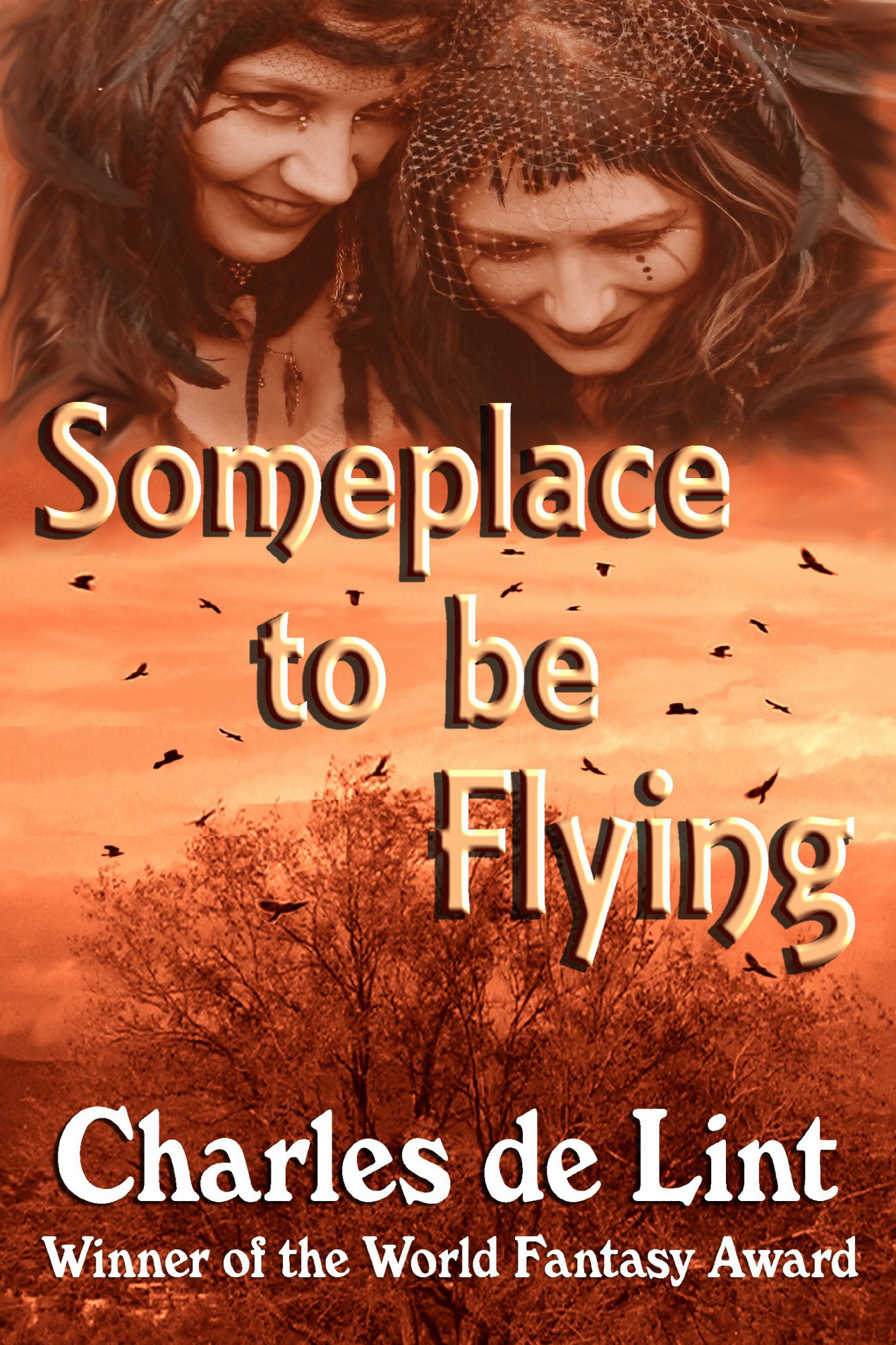 I'll admit it–I didn't read this previously because the cover made me think it was one of the books he wrote as Samuel Key–horror. The new cover does a much better job of making it clear this is in large part about the Corbae.
I'll admit it–I didn't read this previously because the cover made me think it was one of the books he wrote as Samuel Key–horror. The new cover does a much better job of making it clear this is in large part about the Corbae.
But not entirely.
Hank is a living on the edges of society, with the family he's made–Moth, Paris, the rest who hang out at the junk yard, and a giant stray dog.
He'd never given the dog a name, never gave any of the animals he brought back to Moth's a name.
Hank is driving a Gypsy cab when he sees a woman being beaten by a man. When he stops the cab to do something, that's when things take a strange turn. If you're familiar with the Crow Girls, you know they're the ones who appear from seemingly out of nowhere. But I don't think it would make a difference if you weren't familiar with them.
Lily is a photographer, and after she was rescued by Hank, she admits that she's been out looking for the Animal People of Jack Daw's stories.
I like Lily.
She could hear her voice go up on the last syllable, making a question of it. It was an affectation that always irritated her when she heard others do it and it irritated her more now that she was doing it herself.
Then there is Kerry, who has moved into the Rookery, finally on her own after years of being locked up by her family.
Kerry didn't think she'd ever been brave. She could endure, but that wasn't the same thing at all.
And of course, there are the Crow Girls.
"Look at this," Rory said as they joined him on the porch. "Notice how when there's work to be done, the crow girls are never to be found?"
"You really think it would go quicker if they were here to help?" Annie asked.
Rory nodded. "You're right. What was I thinking?"
"We have to go," Zia says.
Maida nods. "We're working on a surprise for Margaret for when she gets back home."
"Do you know where we can get a thousand spiders?" Zia asks.
(twitch)
But the Crow Girls are also wise when they need to be, although they try not to need to be.
"The best change you can make is to hold up a mirror so that people can look into it and change themselves. That's the only way a person can be changed."
"By looking inside yourself," Zia said. "Even if you have to look into a mirror that's outside yourself to do it."
"And you know," Maida added. "That mirror can be a story you hear, or just somebody else's eyes. Anything that reflects back so that you can see yourself in it."
And I was quite amused by this:
"Imagine if life was fair," she says to me one time. "I think maybe that'd be worse."
"How do you figure that?"
"Well, then we'd deserve all the awful things that happen to us, wouldn't we? It'd mean that at some point in our lives—or maybe some life we had before this one—we were pretty creepy people."
I never thought about it like that before. Seems odd to take comfort in life's unfairness, but I start to feel the same way she does.
(If that sounds familiar, you can click on the link to see another iteration of it.)
"Too late," Zia echoed.
"Those are two of the least fun words in the world," Maida said.
Ah, the Crow Girls. And the other Corbae. I'm glad I finally got around to reading this.
Published by Triskell Press
July 2016 | Rating: 9/10
Moonlight & Vines (1999)
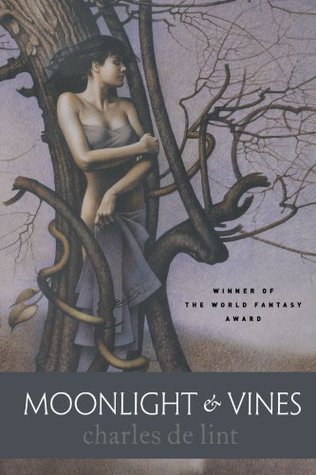 The third (I believe) Charles de Lint short story collection, Moonlight & Vines returns again to Newford. Although it starts and ends with a Christie Riddell story, and there are plenty of appearances by the characters with whom we've become familiar, there are also new characters, some we'll meet again, and some who seem to appear only this once.
The third (I believe) Charles de Lint short story collection, Moonlight & Vines returns again to Newford. Although it starts and ends with a Christie Riddell story, and there are plenty of appearances by the characters with whom we've become familiar, there are also new characters, some we'll meet again, and some who seem to appear only this once.
- "Sweetgrass & City Streets"
- "Saskia"
- "In This Soul of a Woman"
- "The Big Sky"
- "Birds"
- "Passing"
- "Held Safe by Moonlight and Vines"
- "In the Pines"
- "Shining Nowhere but in the Dark"
- "If I Close My Eyes Forever"
- "Heartfires"
- "The Invisibles"
- "Seven for a Secret"
- "Crow Girls"
- "Wild Horses"
- "In the Land of the Unforgiven"
- "My Life as a Bird"
- "China Doll"
- "In the Quiet After Midnight"
- "The Pennymen"
- "Twa Corbies"
- "The Fields Beyond the Fields"

"Sweetgrass & City Streets" is a poem.
I am particularly fond of several of the stories in this collection. In "Saskia," Christie first meets Saskia, we learn a small piece of Geordie and Christie's past, and most importantly, we learn about the Wordwood. I love the Wordwood.
"Saskia" first appeared in Space Opera (1996) and is the introduction of Saskia to Christie and to the series.
What no one seems to realize is that she's always paying attention. She listens to you when you talk instead of waiting impatiently for her own turn to hold forth.
Humanity's whole unfortunate history is one long account of how we attack what we don't understand, what's strange to us.
"In This Soul of a Woman" first appeared in Love in Vein (1994). This isn't a favorite. I don't think vampires really and truly belong in Newford.
"So what does your name mean?"
" ‘Granddaughter.' "
Nita laughed.
"What do you find so humorous?"
Nita flicked her cigarette against the nearest wall which it struck in a shower of sparks. "Sounds to me like your grandmother just found a fancy way of not giving you a name."
"The Big Sky" first appeared in Heaven Sent (1995)
This is another that isn't a particular favorite, again, because this kind of ghost story (although unusual) just didn't feel quite right for Newford.
"You have always been sparing with your kindnesses."
I want to not be that person.
"Birds" first appeared in The Shimmering Door (1996) and is the story of two young women, finding their own ways of dealing with their past traumas.
"Passing" was first published in Excalibur (1995) and is another story that felt like it was squished into Newford rather than being a story that started in Newford on its own. It's not bad, but it just doesn't feel quite right to be set in Newford. I guess there are a lot of stories in this particular anthology that strike me that way.
"Held Safe by Moonlight and Vines" first appeared in Castle Perilous (1996). Now this story I really like. Alex and Lillie grew up together, but their lives were very very different.
"I only ever wanted one thing," I tell her, "but I never had it to lose."
"I don't even know what it is that I've lost," she says. "I just know something's gone. I had a chance to have it, to hold it and cherish it, but I let it go."
"In the Pines" is another favorite, because Darlene seems as if she'd stepped out of Southern West Virginia or anywhere in Appalachia, and I love the idea of a ghost with good intentions. I'm also inordinately fond of this bit: "I don't lead an exciting life, but I'm partial to a lack of excitement. Gets to a point where excitement's more trouble than it's worth..."
"In the Pines" first appeared in Destination Unknown (1997). This is another favorite from this anthology. Darlene has made her way in the world playing music, and sometimes making it. She escaped her family initially by visiting her Aunt Hickory, and then with what her Aunt Hickory gave her. It's a lovely ghost story.
"Doesn't matter how bad it gets, the pain goes away. Sometimes you got to die to stop hurting, but the hurting stops."
"Shining Nowhere but in the Dark" first appeared in Realms of Fantasy, Vol. 3, No. 1, (1996) is a story of death and dreaming.
"If I Close My Eyes Forever" is a rather strange story that, for all I like it, seems somehow out of place in this collection. For all it's fantastic elements, has the tone of hard boiled detective novel, so it's a bit of a jolt, being so different from what comes before and after. Although I have to admit that perhaps the tone is a bit like "China Doll," another story I really like. Both of main characters who appear and then disappear.
"If I Close My Eyes Forever" is about finding the right person. Not a favorite, for no reason I can put my finger on.
I hate being alone. I think that's why my relationships always fall apart. I've got too much need. I am too intense— just like Peter said. But that's because when I'm alone, I think too much. My imagination gets carried away with itself. I imagine the worst. I start to believe there really is a burglar lurking about.
I love the stories within the story of "Heartfires" and I love "Crow Girls," both the story and the characters. I love their trickster nature combined with the fact that they're something more.
"Heartfires" first appeared as a limited edition chapbook (1994). It's the story of Jolene, Bear, Alberta, and Crazy Crow. (They often make brief appearances in other stories.)
"That's just living," she tells the caged woman. "Those aren't bars, they're the bones that hold you together. You keep clawing at them, you'll make yourself so sick you're going to die for sure."
"I can't breathe in here," the caged woman says.
"You're not paying attention," the Lady of the White Deer says. "All you're doing is breathing. Stop breathing and you'll be clawing at those same bones, trying to get back in."
The bones of her prison weren't there to keep her from getting out. They were there to keep her together.
"Crow Girls" first appeared as a limited edition chapbook (1995). This is the introduction to the Crow Girls, who are some of my favorite characters. But it's not really about the Crow Girls–it's about Jilly's friend Heather, and how the Crow Girls change you, just by their being.
"The Invisibles" first appeared in David Copperfield's Beyond Imagination (1997). It's the story of dreams and memories and believing yourself away from the world.
"Seven for a Secret" first appeared in Immortal Unicorn (1995). It's the story of Malicorn and Jake, Staley and William. (Staley and her fiddle appear later.)
"Wild Horses" first appeared in Tarot Fantastic (1997) is the story of siblings and family and love and forgiveness.
"In the Land of the Unforgiven" is another story about an ex-con, and whether some things are so beyond the pale, that sometimes people have no choice but to take their own action. This is a particularly dark story.
"My Life as a Bird" first appeared as a limited edition chapbook (1996). This is the story of how Mona meets Nacky Wilde. I really like this story–most especially the ending.
"China Doll" first appeared in The Crow: Shattered Lives and Broken Dreams (1998). This is another story I didn't particularly like. It's dark (as many of his stories are) but it's more depressing than normal.
"In the Quiet After Midnight" first appeared in Olympus (1998).
"The Pennymen" first appeared in Black Cats and Broken Mirrors (1998). This is a story about art and mental illness and escaping our history.
"Twa Corbies" first appeared in Twenty 3: A Miscellany (1998). This is a story of Jilly and the Crow Girls and an old woman. This is a lovely, brief, tale.
"The Fields Beyond the Fields" first appeared as a limited edition chapbook (1997)This is a Christie Riddle story.
But I love most how these stories make you stop and think. Even when he's talking about the horrors that exist in real life--the horrors that his characters confront--there' still hope.Time passes oddly. Though I know the actual contrast is vast, I don't feel much different now from when I was fifteen. I still feel as clumsy and awkward and insecure about interacting with others, about how the world sees me, though intellectually, I understand that others don't perceive me in the same way at all. I'm middle-aged, not a boy. I'm at that age when the boy I was thought that life would pretty much be over, yet now I insist it's only begun. I have to. To think otherwise is to give up, to actually be old.
There are also bits in this collection that remind me of other things I've read and seen. "The Invisibles" shared elements of a Buffy episode, and I was reminded of Neil Gaiman's Death in the story "Shining Nowhere but in the Dark." Just a odd feeling.
As always, the writing and characters are excellent. The only flaw is that at one point the discussion of the horror of the real world changes from an element of the story, to preaching. I understand that the cause is important, but it steps outside the flow of the story.
It was reading this collection that I came to the realization that most of his best characters are female. Not that I have a problem with a male writer writing female characters, it's just odd to find one who does it well so consistently. And in general he writes more about women. There's Geordie and Christie, and Jack Crow and a couple of other men, but the majorities of these stories have female characters. Strange that I never noticed that until now.
As with all of Charles de Lint's short story collections, you don't have to have read any of his previous works to understand and enjoy this book. Each story stands on its own, and the past history of the characters, like Jilly, adds more depth to the stories, but the stories are fully understandable without that history.
Cover by John Jude Palencar.
Published by Orb
- March 2006 | Rating: 8/10
- July 2016 | Rating: 8/10
The Onion Girl (2001)
 The only author I possibly like more than Steven Brust, is Charles de Lint. There is nothing he has written that I have not liked, and most of what he has written I really love. Despite that, and despite buying this book over a year ago, I had not gotten around to reading it until this winter, which requires some explanation.
The only author I possibly like more than Steven Brust, is Charles de Lint. There is nothing he has written that I have not liked, and most of what he has written I really love. Despite that, and despite buying this book over a year ago, I had not gotten around to reading it until this winter, which requires some explanation.
Charles de Lint has written a series of books and short story collections that take place in the town of Newford. Although the books, especially the short story collections, do not need to be read in any particular order, there is a greater sense of character development if they are read in order. This is, I think, particularly more important for the novels, where I think you get a greater sense of continuity and a better knowledge of what makes the characters tick.
Onion Girl is Jilly Coppercorn's story, and delves into her past, and that is the reason that I hesitated for so long to read this book, for Jilly Coppercorn does not have a pleasant past, and so I knew that at least parts of this book were going to be hard to read, but probably no more so than some of his short stories. Regardless, sometimes you need to build yourself up to reading a book that you know is going to be painful in places.
And it is painful in places. But it is also an absolutely fantastic book, and one that expands Jilly Coppercorn, both her history and where she has been going in the stories. My only problem is that I had a tendency to want to yell at Charles de Lint and say "Haven't you put her through ENOUGH already? Isn't it time for good things to happen to Jilly?" I know. I know. They're only made up characters. But that doesn't mean I don't get invested and I don't care what happens.
Despite that, this was a very good book, and one that any devoted fan of Newford must read. Although this is not necessarily the first book by Charles de Lint that someone should pick up and read. I'd suggest his short story collections, but then I'm a fan of short stories, so take that advice with that particular bit of knowledge in mind.
As far as this book goes, as is typical for me, his books are ones that I read in a rush, lying down and devouring whole chapters at a time. I read this book in two evenings, the first night reading the first quarter of the book, the second night staying awake until 3am to finish the book.
As I said, it's not particularly easy book to read, but then many of his short stories also have a similar dark thread running through them. Regardless, it is an excellent book, and the first to truly center around Jilly. If you have not read one of Charles de Lint's books before, you may want to start with one of his earlier anthologies. If you have previously read Charles de Lint's Newford stories, then you will definitely want to read The Onion Girl.
Cover by John Jude Palencar.
- January 2004 | Rating: 8/10
- March 2006 | Rating: 8/10
Tapping the Dream Tree (2002)
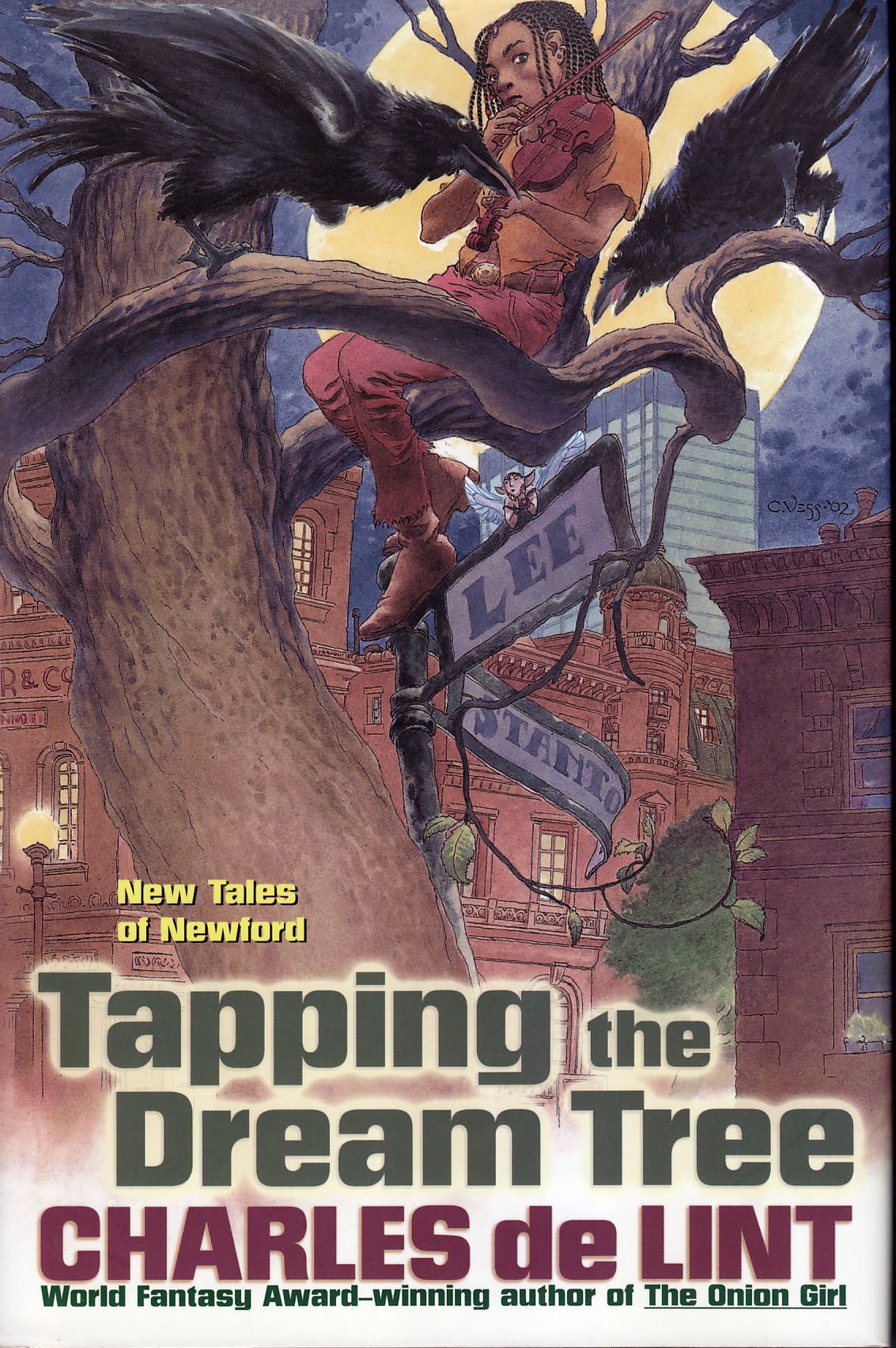 Tapping the Dream Tree is the fourth collection of Charle de Lint's short stories based in Newford. It's also my favorite collection so far.
Tapping the Dream Tree is the fourth collection of Charle de Lint's short stories based in Newford. It's also my favorite collection so far.
Several stories where Jilly makes an appearance, as well as several other favorite characters, and several new characters, or characters who made a brief appearances in other stories, and return in Tapping the Dream Tree with their own stories.
- Ten for the Devil
- Wingless Angels
- The Words That Remain
- Many Worlds Are Born Tonight
- The Buffalo Man
- Second Chances
- Forest or Stone
- Embracing the Mystery
- Masking Indian
- Granny Weather
- The Witching Hour
- Pixel Pixies
- Trading Hearts at the Half Kaffe Café
- Making a Noise in This World
- Freak
- Big City Littles
- Sign Here
- Seven Wild Sisters
Ten for the Devil (1998) from Battle Magic. Staley has a blue fiddle that calls of magic. Or so she's been told. Unfortunately, she accidentally calls up some things that are not so calm and benign. This has a lovely Robert Johnson bit.
"Long as the day is wide?" she asked.
"Well, you know. Start to finish, the day only holds so many hours, but you go sideways and it stretches on forever."
Wingless Angels (2000) from Black Gate is one of the darker stories, and not a particular favorite.
The Words That Remain (2000) from Taps and Sighs is a short ghost story. It's got Christy Riddle, and I quite like it.
Many Worlds Are Born Tonight (2000) from Lisa Snelling's Strange Attractions is another story I don't much care for. It's about an Ferris Wheel that can take you to any of the possibilities created whenever you make a choice.
The Buffalo Man (1999) is a Meran and Cerin story with Lucius and the Crow girls and Jilly.
"You wouldn't have any crow blood in you, would you?"
"Nary a drop."
Lucius harrumphed and muttered, "I'd still like to see the results of a DNA test."
"What was that?"
"I said, I wonder where they keep their nest."
How can a smile, a laugh, a good deed, stand up against the weight of such a history?"
"I… I guess it can't," Jilly said. "But you still have to try."
"Why?"
"Because that's all you can do. If you don't try to stand up against the darkness, it swallows you up."
Second Chances (1998) has Meran, but it's mostly about Joey Straw and second chances and being more than our genes and history.
There are people that need stories, that can't exist without them. I'm one of those people, always have been. Nose in a book, ear cocked for gossip, wouldn't go to bed without a story and that lasted for a lot longer for me than it does for most kids. I still read for an hour or so before I go to sleep.
And stories.
Forest or Stone (1999) from Merlin is a Jilly and Geordie story and keeping promises.
"Doing it like you mean it. You'd be surprised how much satisfaction you can get from the simplest task if you impart it with meaning."
Embracing the Mystery (2000) from Spell Fantastic is a Wordwood story that also is about Sue Ash and her inherited dog Fritzie.
They work because they make us concentrate so completely that the magic has to pay attention to us. It's like communion and singing hymns in church. People really do get closer to God because they're focusing on these rituals and no longer listening to that constant dialogue that goes on inside their heads."
Masking Indian (2000) from Mardi Gras Madness is set partially in Newford and in the past in New Orleans.
Granny Weather (2000) from Imagination Fully Dilated is a Sophie and Mabon story.
I can feel my anxieties lose some of their immediacy. The dark holes are still there, but I'm no longer so panicked that I think they're going to swallow me whole.
The Witching Hour is one of the darker stories, about Christy and Geordie's other brother, and about damnation.
Pixel Pixies (1999) is an amusing story. This has bad faeries offset by a good faerie. And a bookstore.
The pixies were truly puzzled by the book. I suppose it would be odd from any perspective, a book that old, never once having been opened or read. It defeated the whole purpose of why it had been made.
Trading Hearts at the Half Kaffe Café (2001) from Single White Vampire Seeks Same is another fun story, although it has the potential for very bad things to happen.
Making a Noise in This World (2000) from Warrior Fantastic is a story about Native Americans / First Peoples (however you want to classify them). I quite like the outcome of this story.
Freak (2001) The Mutant Files is a really depressing and upsetting story. Just so you know.
Big City Littles (2000) is another story with Meran, and about faerie.
What good were promises if you didn't keep them? How could you respect yourself, never mind expect anyone else to respect you, if you could break them so easily?
Sign Here (2002) from Apprentice Fantastic is an interesting story, but I don't especially care for it.
Seven Wild Sisters (2002) is one of the longer stories and I actually have an illustrated book of this story.
Sarah and her seven sisters moved to the country, and live just a few miles from the woman they eventually came to call Aunt Lillian (after determining that she was not, in actuality, a witch). As Sarah spends more time with Aunt Lillian, she eventually discovers that although the older woman's way of life may seem crazy, but it actually has much to recommend.
"Used to live with my aunt, but she passed away some time ago, God rest her soul."
"Without running water or TV or anything?"
"Without anything? Girl, I've got the whole of the Lord's creation right at my front door."
It's also a story–like so many of Charles de Lint's, where the girl gets to rescue herself.
In "The Buffalo Man," we get to visit with Meran and Cerin, who have been missing from the last two volumes. "Pixel Pixies" is a very interesting idea, that pixies have gotten into the Internet. I know that sometimes I'm convinced that sometimes my computer knows precisely the wrong time to crash, taking out hours of work. "Granny Weather" is another story of Sophie Etiole's serial dreaming, and she must visit Granny Weather, who advised her when she rescued the moon.
"The Witching Hour" is an interesting story that gives us another hint into the past of Geordie and Christie. It's a horror story, but it's more dark than scary.
I particularly like "Sign Here." It's very different from the other stories in the collection; it's completely dialog. No descriptors or anything else. Additionally, I find the story very amusing.
This is an excellent collection. All my favorite characters are here, and the writing and and storytelling are fantastic as usual. If you have not read any Charles de Lint before, this would be an excellent book to start.
Cover by Charles Vess.
Published by Tor
- March 2006 | Rating: 10/10
- June 2016 | Rating: 9.5/10
Waifs and Strays (2002)
 Charles de Lint's latest short story collection is not as much for young adults as it is about young adults. As I recognized several titles in this collection from other collections, I hadn't been in a hurry to get this collection. That was my mistake. Only the last stories in the book are set in Newford, the rest of the stories in the book were all ones I had not read before.
Charles de Lint's latest short story collection is not as much for young adults as it is about young adults. As I recognized several titles in this collection from other collections, I hadn't been in a hurry to get this collection. That was my mistake. Only the last stories in the book are set in Newford, the rest of the stories in the book were all ones I had not read before.
I love Charles de Lint's stories, and I typically snatch up his books as soon as I see them. I have, however, hesitated for several of his recent books, which are re-releases of horror books he wrote under the name Samuel M Key. As I really don't care for horror, I've been wary of picking up anything of his recently, for fear of getting a horror book. I'm beginning to wonder whether that too was a mistake.
I particularly liked "There's No Such Thing", and "Sisters", two stories with the same characters that were quite different from his other stories that I have read, in that normally he doesn't deal write about things like vampires (In the introduction to Sisters he says that although he takes some pokes at Buffy, he's been a fan since he first saw it.) I very much liked "Fairy Dust", but liked "The Graceless Child" even better.
There were two stories from the Bordertown anthologies, "Stick" and "May This Be Your Last Sorrow". I hadn't heard of the Bordertown stories, which is my loss, because Charles de Lint's stories reminded me of a cross between Newfound and Thieves' World. But I put them on my wish list, just in case.
The Newford stories I already had in other collections, and although they are about young adults, they were not necessarily some of my favorite Newford stories. The two Maisie Flood stories, "But for the Grace Go I", and "Waifs and Stays", I do like, but "Ghosts of Wind and Shadow" is not one of my favorite stories. I just found it hard to feel sympathy for Lesli.
If you have not read anything by Charles de Lint before, I would recommend this as a good starting place. It gives you a good sample of his excellent writing, and gives you as introduction to Newford, the place where most of my favorite tales are set.
Cover by John Jude Palencar
Viking
July 2004
Spirits in the Wires (2003)
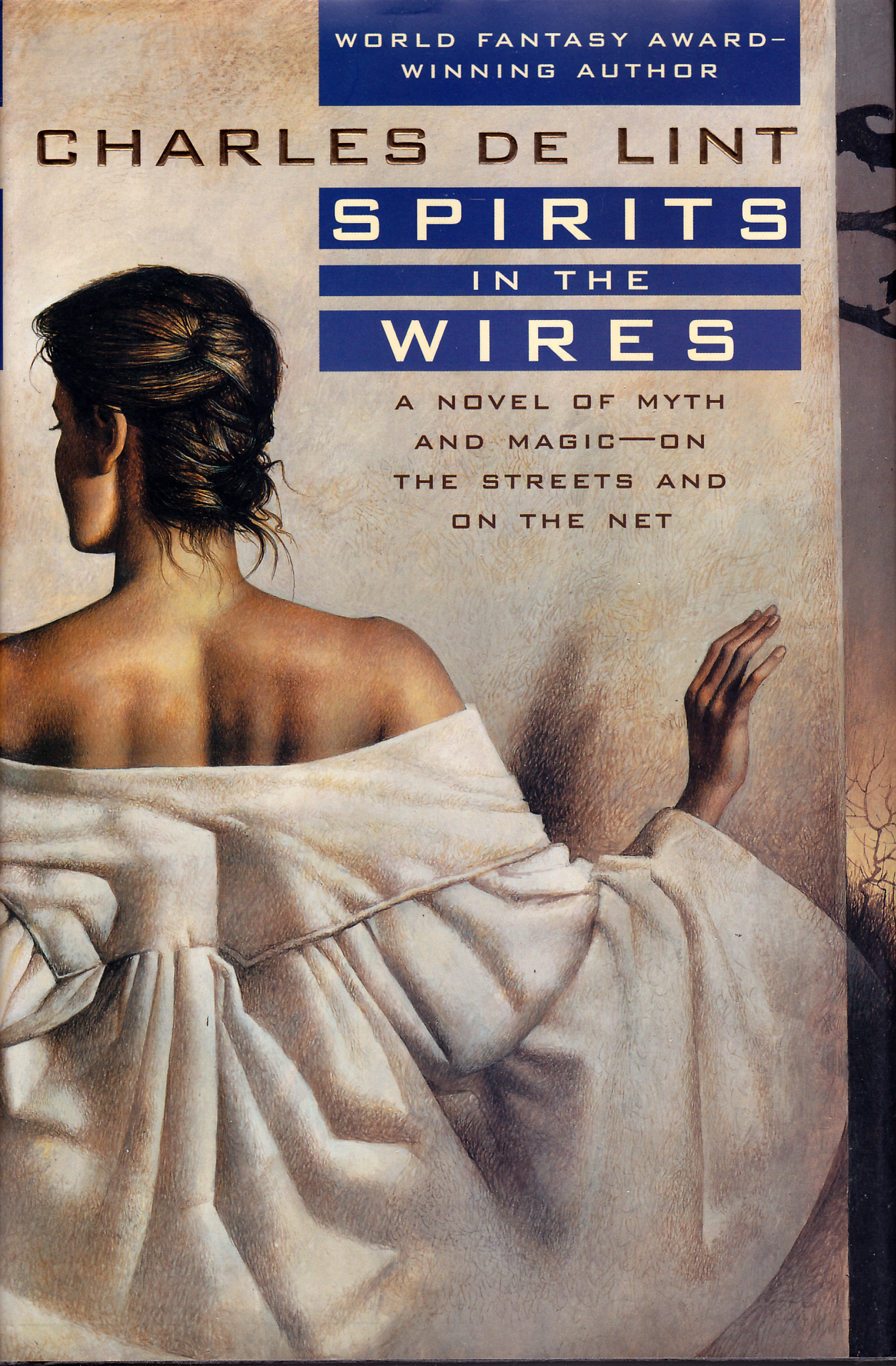 Spirits in the Wires is the story of the Wordwood, the literary internet site set up by Holly and others that has taken on a life of its own. Saskia Madding is an independent being, created by the Wordwood, and sent out into the World As We Know It, where she has fallen in love with Christy Riddle, and he with her. All of this is past history as we start Spirits in the Wires.
Spirits in the Wires is the story of the Wordwood, the literary internet site set up by Holly and others that has taken on a life of its own. Saskia Madding is an independent being, created by the Wordwood, and sent out into the World As We Know It, where she has fallen in love with Christy Riddle, and he with her. All of this is past history as we start Spirits in the Wires.
In Spirits in the Wires, Saskia meets up with Christiana Tree, Christy Riddle's shadow, who is, although a resident of the Borderlands, a frequent visitor to the World As We Know It, and in sometimes contact with Christie.
Because the Wordwood has taken on a life of its own, and taken up residence in the Borderlands, its fall is a threat not just to those involved with the site, but to the Borderlands as well.
One of my favorite parts of Spirits in the Wires is the passage describing the healthy Wordwood.
"The grass and wildflowers are narrow phrases, swaying in the wind, punctuated with blossoms whose wordy petals radiate from clusters of vowels. The trees are thick paragraphs, dense with description, that lighten into shorter sentences and finally simply words as they follow the natural progression of trunk to branch to twig to leaf. Small verbs and nouns scamper along the branches, trilling sweet wordsongs, or soar by on wings of poetry."
Woods and a library combined. What more could one want?
I'm also very fond of Christiana's thoughts on changing:
But I don't want to change. I don't want to be someone else. Truth is, the idea of it kind of scares me. I remember, growing up, how I'd hear other people wishing they were someone else--and I still overhear that in conversations--but I've only ever wanted to be me. Me, with all my faults and scraped knees and bruised heart and all. I know I've done some dumb things, and into more trouble than I should have, but those mistakes and escapades helped shape sho I am.
Although most of the characters exist in previous stories and books, this book should easily be able to stand on its own, for someone who knows nothing about Newford of any of its population, more so I think than The Onion Girl.
Now that I've read two de Lint's in a short period of time, I desperately want to go back and reread the rest of his books, especially his short story collections. I want to go back and read the first story in which Jilly appears. I want to read about Mabon, Sophie Etiole's domain. I want to read about the Borderlands and the Hob that lives in the bookstore.
I want Charles de Lint to write more books about Newford.
And soon.
Cover by John Jude Palencar
Tor
- January 2004 | Not Rated
- March 2006 | Rating: 9/10
Widdershins (2006)
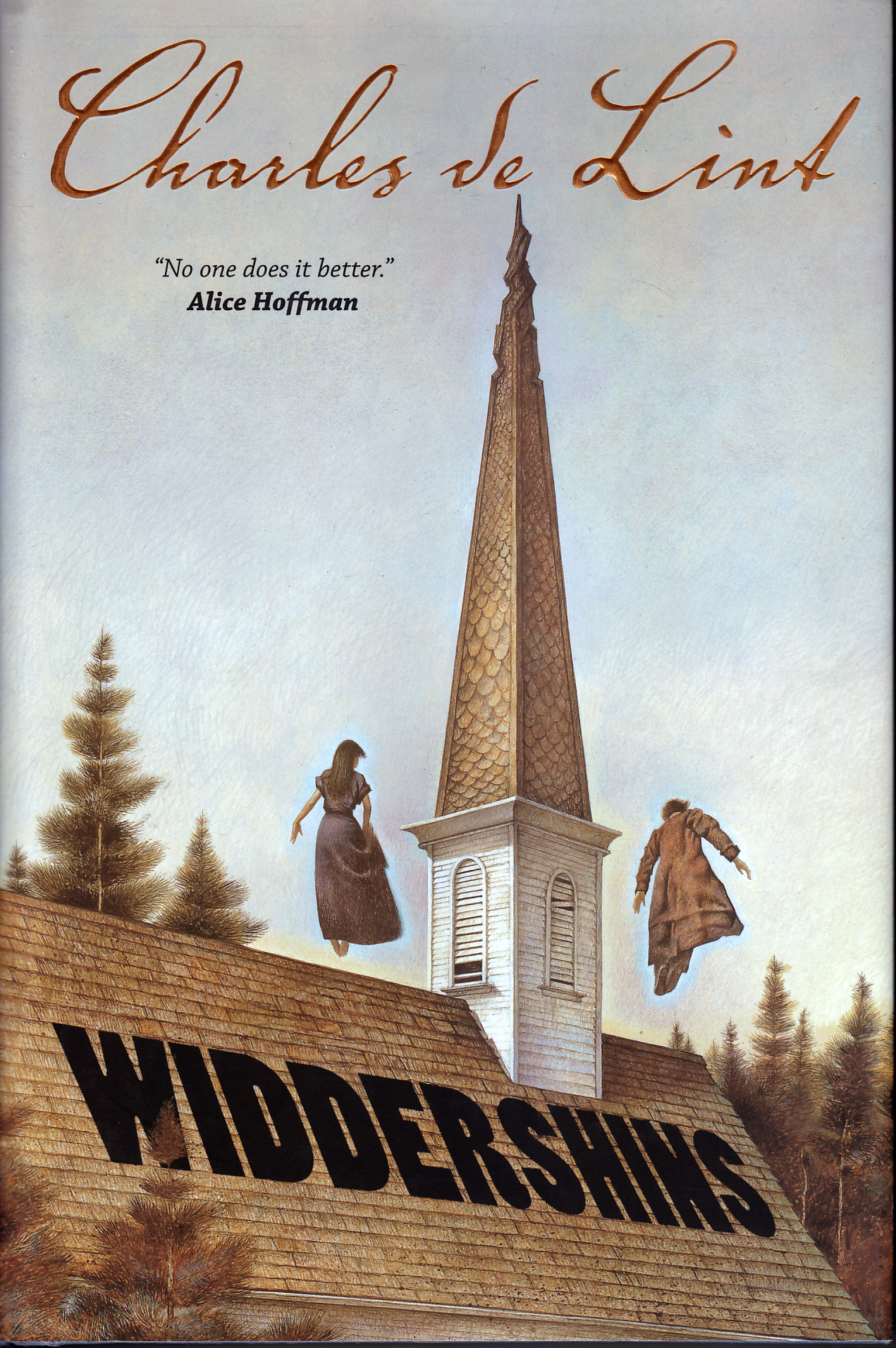 Widdershins is the latest book by Charles de Lint, and I debated for about a month as to whether I wanted to buy it in hardback or wait for it to come out in paperback. First there was the fact that I own Spirits in the Wires and Tapping the Dream Tree in hardback. But the biggest deciding factor was knowing that this book was about Jilly and Geordie. Although Jilly's story was resolved at the end of The Onion Girl, things weren't really that great, and I was really hoping that things would get better for her.
Widdershins is the latest book by Charles de Lint, and I debated for about a month as to whether I wanted to buy it in hardback or wait for it to come out in paperback. First there was the fact that I own Spirits in the Wires and Tapping the Dream Tree in hardback. But the biggest deciding factor was knowing that this book was about Jilly and Geordie. Although Jilly's story was resolved at the end of The Onion Girl, things weren't really that great, and I was really hoping that things would get better for her.
Although this book is ostensibly about Jilly and Geordie, the greater part of the story--and the most difficult part of the story--was about Jilly. Jilly is still not fully recovered from her accident, and is told that she may not fully recover until she finally deals with her past, and the abuse she suffered.
Geordie already has, to a great degree, dealt with his past. He and Christie have attempted to deal with their past, and to maintain a relationship and friendship that neither thought they could ever have. However, he must also deal with the fact that all of his past relationships have failed.
Meanwhile, tensions are brewing between the spirits who are native to the land, and the faerie who came over from Europe. Certain groups are bidding for power, while others are seeking revenge, and the fiddler Lizzie and her band are accidentally caught up in the hostilities.
As usual, this was a story that sucked me in almost immediately, and I hard a hard time putting it down. Of course I feel that way about all of Charles de Lint's writing, but this book was no exception.
I was trying to decide whether you could read this book without having read and previous Newford stories, and decided that although you probably could, it most likely wouldn't mean as much--especially the bits about Jilly. She's been through so much, that you can't help but cheer her on, and I'm not sure how much of that you'd feel if this was your first introduction to her. So although most Charles de Lint books can stand on their own, I'm not sure that I would recommend this without reading at least The Onion Girl.
Very strangely, the end of this book felt almost like a conclusion to the Newford stories. Several loose ends were tied up by the end of the book, which was surprising. I'm not saying that all Charles de Lint stories are depressing, but they typically have a dark (sometimes very dark) thread running through them, and there is typically not the happy ending you would expect. This story is dark--after all, we're dealing with Jilly's past, but the overall feel of the book was not as dark as many earlier books.
All in all, what I liked best about Widdershins was the resolution of some story arcs, and the fact that we get to see Jilly deal with some of her issues that were unresolved.
Plus, the Crow Girls.
If you have not read any other books by Charles de Lint, I recommend starting with one of his anthologies, and then coming back and reading this after you've gotten to know Newford and it's characters better. I think you'll enjoy the story better that way.
Cover by John Jude Palencar.
Tor
July 2006 | Rating: 8/10
Promises to Keep (2007)
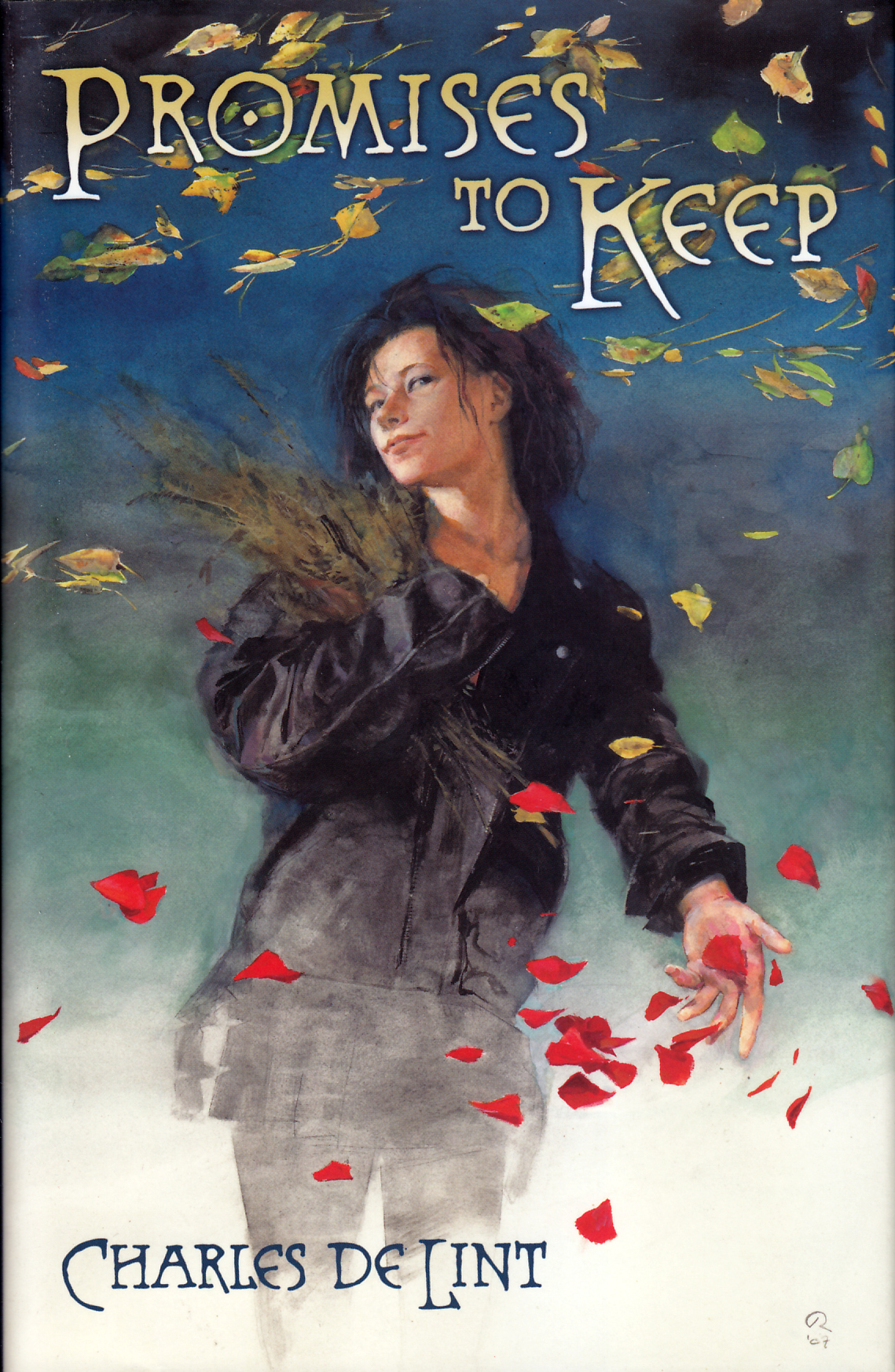 Charles de Lint said he wasn't going to write about Jilly any longer–he'd already done plenty to her in The Onion Girl, and resolved things for her in Widdershins, but in Promises to Keep we get to go back to Jilly's past. Not the terrible past, but the time when she was pulling her life together.
Charles de Lint said he wasn't going to write about Jilly any longer–he'd already done plenty to her in The Onion Girl, and resolved things for her in Widdershins, but in Promises to Keep we get to go back to Jilly's past. Not the terrible past, but the time when she was pulling her life together.
She does talk somewhat about the horror of her past, which is still hard reading even if we only get a glimpse rather than the details, but the focus of the story is of Jilly's recovery and how she came out of her shell her first year at the University.
It's also how she deals with her past come back to haunt her.
I love Charles de Lint's writing. Whenever I get a new book I always put off reading it for awhile, for whatever reason. Then when I break down and finally read the book I wonder why on earth I waited so long.
Well, in this case it was knowing Jilly's past, and not being sure if I wanted to revisit any part of it. Although her past is difficult, this book is not as heavy and dark as The Onion Girl, which was very good, but also very dark. We see instead Jilly overcoming the horrors of her past instead of reliving her past.
Can you read Promises to Keep without having read about Jilly previously? Yes. Of course, the it's a different feeling about the resolution. Having read about Jilly in the future, the question is not what happens, but how does it happen. Someone who has never read about Jilly previously might take the story quite differently.
Regarding the book itself, I got the Subterrean Press hardcover, which is a beautiful version. It's not a large book–it's a novella not a novel, but the cover is wonderful, and I love the embossed paper inside the cover. It feels like Jilly deserves it.
If you've never read Charles de Lint, you could easily start here. If you're a Charles de Lint fan, you probably read this when it first came out, and I'm behind the times.
Cover by Mike Dringenberg
Subterranean Press
February 2009 | Rating: 7/10
Muse and Reverie (2009)
 I love Charles de Lint's writing.
I love Charles de Lint's writing.
The last Newford short story collection was in 2002, so it was quite a wait for this fifth collection.
In the interim of course, he has had stories in a variety of anthologies, many of which I have, some of which I picked up solely because he had a story in the collection. And I just realized there are a lot of other anthologies in which he has stories, which must not be Newford stories, because they aren't in this collection.
So what are the Newford stories? They're set in the city of Newford, which is in either Canada or the US, and is a place where the world of magic is close to our world. Many of the stores have mythic origins, others have the feel of stories of stories you heard as a kid, that happened to a friend of a friend.
What they are not are paranormal or supernatural fantasies. They're simply classic fantasy transferred to the city. They're strange happenings–homeless disappearing, dream visitations from the dead, a small box that contains the entire world–that could be happening right now in the world in which we live.
As I said, several of the stories I'd read before. "Somewhere in My Mind there Is a Painting Box" the story that opens this anthology, was one of those, and is one of the strongest stories in this anthology.
- Somewhere in My Mind There Is a Painting Box (2002)
- Refinerytown (2001)
- A Crow Girls' Christmas (2001)
- Dark Eyes, Faith, and Devotion (2005)
- Riding Shotgun (2003)
- Sweet Forget-Me-Not (2002)
- That Was Radio Clash (2004)
- The Butter Spirit's Tithe (2004)
- Da Slockit Light (2003)
- The Hour Before Dawn (2005)
- Newford Spook Squad (2004)
- In Sight (2005)
- The World in a Box (2004)
The Crow Girls made several appearances, and were the center of their own story about Christmas, which was a lovely romp (pretty much what you'd expect from the Crow Girls).
Somewhere in My Mind There Is a Painting Box from Green Man: Tales from the Mythic Forest. I won't say this is one of my favorite stories, because I'm not sure how I would even be able to narrow that list down to something that wasn't almost all of his stories, but I do like this one. Lily lives with her Aunt who took her in when she was orphaned. When the chores of the farm are done, she wanders into the woods, "walking in these woods of hers was a sure cure for any ailment, especially when it was in your heart or head," drawing and sketching on scraps of paper she salvages (this seems to be set around the time of the Great Depression).
This story has some marvelous bits, from the importance of being out in the woods to the importance of living in the present.
"Sometimes people need fairies and fancies to wake them up to what they already have. They look so hard for the little face in the thistle, the wrinkled man who lives in a tree. But then they start to focus on the thistle itself, the feathery purples of its bloom, the sharp points of its thorns. They reach out and touch the rough bark of the tree, drink in the green of its leaves, taste of its fruit. And they're transformed. They're in their own world, fully and completely, sometimes for the first time since they were a child, and they're finally appreciating what it has to offer them.
Refinerytown is a Mona story that has appearances by Jilly and Sophie. Mona is a comic strip artist who is collaborating on a different kind of strip–a non-autobiographical one. So she thinks. This story amuses me because it is absolutely full of name dropping, from Nina Hoffman to Charles Vess. It's delightful.
This story takes place after Jilly's accident.
A Crow Girls' Christmas. The Crow Girls are a delight. I'm not sure I could take them long term, but in small doses they are lovely.
"Do they have lots of candy canes in stock?" Jilly asked.
"Mountains," Zia assured her.
"Besides," Maida added. "It's all magic, isn't it? Santa never runs out of candy or toys."
That was before you were put in charge of the candy canes, Jilly thought, but she kept her worry to herself.
Dark Eyes, Faith, and Devotion from Magic Tails is a darker tale, but it's also one I quite like. A Gypsy cab driver picks up a young woman who requests his help getting back her cat.
"Sometimes we don't fulfill our potential only because there is no one in our life to believe in us."
Riding Shotgun from Flights. This is another dark story, but it's also one of redemption and second chances and how those don't always turn out to be as you expect.
The old man didn't get it— because it was different for his generation, I guess. You figured out what you wanted to be, what you could be given your situation in life, and that's what you aimed for. He couldn't understand that not only did I not know, I didn't care.
Sweet Forget-Me-Not is a Gemmin story. It's also a story that makes note of changing times.
"What's your name?" he asked.
"Ahmad Nasrallah."
"Well, what are they ragging you about? You look like a nice, normal kid."
"No, I look like a terrorist."
He studied me for a long moment, then gave me another nod, a slow one this time. "Because of the colour of your skin," he said.
"Yeah. And my name."
That Was Radio Clash from Taverns of the Dead. This is a time travel-ish story, and I generally dislike time-travel stories, but this one I like. It's an ode to Joe Strummer, and another story about second chances.
The Butter Spirit's Tithe from Emerald Magic: Great Takes of Irish Fantasy. I'd forgotten this one entirely, so reading it was very enjoyable, pretty much like reading it again for the first time. This is a story where Faerie are anything but benign.
Da Slockit Light has Meran & Cerin and the Crow Girls and Goon and Jilly, but mostly it's about a young boy living on the streets and what kids like that may or may not need.
He heard the crowd wailing. Froome screeching.
And then he heard the sound of a harp and he figured he'd died and somehow managed to luck his way into Heaven, because where else did you hear harps?
"I am not happy," a deep, resonating voice said.
Uh-oh, Louie thought. They figured out that I'm not supposed to be here in Heaven.
This is another story where Faerie are not so benign, but also how conflicts look different depending upon what side you're standing on.
The Hour Before Dawn is a story about ghosts.
"You know, I never much cared for you when you were alive, and dead's not turning out to be much of an improvement."
And a man who came back from the Korean war with literal ghosts.
I don't think anybody who goes to war can ever really let it go. Those first few weeks you're home, they treat you like a hero. But eventually you have to live with the memories you've got sitting in your head.
Newford Spook Squad from Hellboy: Odder Jobs. I have the three Hellboy collections, but for some reason haven't gotten around to reading them. I should remedy that, because with three volumes, some are bound to be as good as this one.
In Sight from Maiden, Matron, Crone. This one is actually not one of my favorites, although it's not bad. It just feels like it's missing something.
The World in a Box is a very interesting story about the power and the ability to wisely use power. Except, not that highfalutin.
Mostly, we just seem to muddle through our lives, and maybe that's what we're supposed to do. Learn what we can as we live our lives and make sure that we bring what goodness we can into the world at our individual level as we try to win back the darkness one little bit at a time.
I think that what I love best about Charles de Lint's stories is that they are often about redemption. Not overtly so in an in-your-face manner, but in a way that makes you stop and consider the wishes we make every day, "if only…"
And one last thing for me to love–I absolutely adore the cover for this book. He tends to get amazingly fabulous covers, that somehow manage to give you the feel for the stories, without actually having to be about any one of the stories in particular. The covers are ethereal, much like his stories.
Cover by John Jude Palencar
Published by Tor
- March 2011 | Rating: 9/10
- June 2016 | Rating: 10/10
The Very Best of Charles de Lint (2010)
I love Charles de Lint. I believe I have all of his mass published story anthologies, and several of the smaller press novellas, so I'd read most of the stories in this collection.
Doesn't matter.
I can read his stories time and again, and there is just as much magic as there was the first time.
This collection was created when he asked his readers to help him create this collection–to help him pick out the very best of his short stories.
There are, unsurprisingly, a lot of Newford stories here, since many of his collection are Newford centered stories. So we get to spend time with Jilly and Sophie and Georgie. But there are non-Newford stories here as well, and a handful I had not read previously.
My editor here at Tachyon was set on using the title The Very Best of Charles de Lint and I had no idea how to choose what would be included. Selecting my favourite stories would have been hard (because they're all like my kids and how do you choose which of your kids is your favourite?), but with a lot of back-and-forthing, it would probably be doable. But my best stories?
I really didn't know where to begin. I have my own ideas as to which are the best, but my judgement is coloured by circumstances and events that have less to do with the actual stories themselves and more to do with what was going on in my life while I was writing them, or what I was trying to accomplish. The actual best stories? How could I ever be objective enough to put such a collection together?
So he asked his readers to give him their favorite stories, and the ones they thought the best, and go from there.
If you have not read any Charles de Lint before (this strikes me as a nonsensical thing, yet I know there are lots of people out there who have not read Charles de Lint) then this is the collection for you.
- In Which We Meet Jilly Coppercorn
- Coyote Stories
- Laughter in the Leaves
- The Badger in the Bag
- And the Rafters Were Ringing
- Merlin Dreams in the Mondream Wood
- The Stone Drum
- Timeskip
- Freewheeling
- A Wish Named Arnold
- Into the Green
- The Graceless Child
- Winter Was Hard
- The Conjure Man
- We Are Dead Together
- Mr. Truepenny's Book Emporium and Gallery
- In the House of My Enemy
- The Moon is Drowning While I Sleep
- Crow Girls
- Birds
- Held Safe by Moonlight and Vines
- In the Pines
- Pixel Pixies
- Many Worlds Are Born Tonight
- Sisters
- Pal O' Mine
- That Was Radio Clash
- Old Man Crow
- The Fields Beyond the Fields
"In Which We Meet Jilly Coppercorn" – The heart of the Newford stories is, of course, Jilly Coppercorn. The first story introduces those who are unfamiliar with Newford to Jilly, but also to what they are going to be reading.
"The world as we have it," he went on to Jilly, "is here mostly because of habit."
"Coyote Stories" is full of Native American mythos, and living between but never entirely in two different cultures.
We have the stories and they'll give us the one thing nobody else can, the thing we can only take for ourselves, because there's nobody can give you back your pride. You've got to take it back yourself.
It's also, like so many other stories, sad and uplifting at the same time, which is another major theme running through his work.
"Laughter in the Leaves" is the first Meran and Cerin story in the anthology, "The Badger in the Bag" is the second Meran and Cerin story, and "And the Rafters Were Ringing" is the third in a row, and the last of thier stories set outside Newford.
"Merlin Dreams in the Mondream Wood" is a stand-alone story in that it's not a Newford story or related to any other recurring characters.
"The Stone Drum" returns us to Jilly and Goon.
"…(Y)ou're talking in riddles just like a wizard out of some fairy tale. I never understood why they couldn't talk plainly."
"That's because some things can only be approached from the side. Secretively. Peripherally."
"Timeskip" is one of the stories I find particularly said, although there are others that are far sadder in result. Like "Freewheeling", which is just plain sad.
"A Wish Named Arnold"
Marguerite kept a wish in a brass egg and its name was Arnold.
"Into the Green" is another story set outside of our world, perhaps in Faerie, perhaps in a past that never quite was, just like "The Graceless Child". It is possible it is also the first Charles de Lint story I read, since it appeared originally in Sword and Sorceress V.
"Winter Was Hard" returns us to Jilly and Newford, and Jilly's ability to see and share magic everywhere.
"The Conjure Man" is another Newford story in which Jilly is only a secondary character, but it's one of my favorites. Possibly in the top five.
"We Are Dead Together" is set outside of our world and is a vampire story of a sort.
"Mr. Truepenny's Book Emporium and Gallery" is one of my favorites. It's about Sophie and her dream world.
"In the House of My Enemy" is possible the most depressing story in the lot, but it's also an amazing story, and one I always re-read, even knowing how sad it is.
"The Moon is Drowning While I Sleep" this is another Sophie Etoile story, and the story in which she meets Jeck.
"Crow Girls" is a story about the two crow girls who make appearances here and there in Newford and elsewhere.
Sometimes they forget they're crows, left their feathers behind in the long ago, and sometimes they forget they're girls. But they never forget that they're friends.
"Birds" is another depressing story, yet it's also redemptive, and lets you see you can move past your past.
"Held Safe by Moonlight and Vines" is a love story of sorts–or at least of a Charles de Lint sort.
"In the Pines" is another of my favorites, of a woman who lives her dream, regardless of whether it brings her success of fame.
I don't lead an exciting life, but I'm partial to a lack of excitement. Gets to a point where excitement's more trouble than it's worth.
"Pixel Pixies" is tangentially about the Wordwood, but it's mostly about hobs and the internet and Meran.
"Many Worlds Are Born Tonight" is probably my lest favorite story in the collection. It's not bad, I just don't care for it.
"Sisters" is another of my favorites–it's a vampire story, except of course that Charles de Lint does vampires quite differently.
"Behind the wheel. You can drive, right?" To some remote location, Apples supposed. Where he'd have his nasty way with her. Or kill her. Probably, he planned to do both, hopefully in that order. Though technically, any physical relationship with her had to be classified as necrophilia. Ehew.
"Pal O' Mine" is another story that makes me cry. I re-read it, but it still makes me cry.
Gina always believed there was magic in the world. "But it doesn't work the way it does in fairy tales," she told me. "It doesn't save us. We have to save ourselves."
"That Was Radio Clash" is another favorite story–one of second chances.
"Old Man Crow" is another story, perhaps similar to Coyote Stories, but perhaps not.
"You need to remember," he told her, "that you don't have another life in the bank. You got to make the most of the one you're living right now."
"The Fields Beyond the Fields" is the closing story, and although it's not a bad story, it's not ma favorite story. But even then there are still pearls of wisdom.
…worrying about "what if" only makes you miss out on "what is"…
That's something to remember.
I will note, however, that like his other collection, many of these stories have a dark theme. There are many abused children, and many of Jilly's stories talk of her the dark of her past. Yet, even in the darkest stories, there is still light and hope, of life going on.
And underlying everything is magic–the other world, be it the Crow Girls or the dream world or fairies. It's all wonderful to me.
Cover by Charles Vess
Published by Triskell Press
- November 2012 | Rating: 9/10
- July 2015 | Rating: 9.5/10
Newford Stories: Crow Girls (2015)
- Crow Girls
- Twa Corbies
- The Buffalo Man
- A Crow Girls' Christmas
- Make a Joyful Noise
"Crow Girls" first appeared as a limited edition chapbook (1995). This is the introduction to the Crow Girls, who are some of my favorite characters. But it's not really about the Crow Girls–it's about Jilly's friend Heather, and how the Crow Girls change you, just by their being.
"Twa Corbies" first appeared in Twenty 3: A Miscellany (1998). This is a story of Jilly and the Crow Girls and an old woman. This is a lovely, brief, tale.
The Buffalo Man (1999) is a Meran and Cerin story with Lucius and the Crow girls and Jilly.
"You wouldn't have any crow blood in you, would you?"
"Nary a drop."
Lucius harrumphed and muttered, "I'd still like to see the results of a DNA test."
"What was that?"
"I said, I wonder where they keep their nest."
How can a smile, a laugh, a good deed, stand up against the weight of such a history?"
"I… I guess it can't," Jilly said. "But you still have to try."
"Why?"
"Because that's all you can do. If you don't try to stand up against the darkness, it swallows you up."
A Crow Girls' Christmas. The Crow Girls are a delight. I'm not sure I could take them long term, but in small doses they are lovely.
"Do they have lots of candy canes in stock?" Jilly asked.
"Mountains," Zia assured her.
"Besides," Maida added. "It's all magic, isn't it? Santa never runs out of candy or toys."
That was before you were put in charge of the candy canes, Jilly thought, but she kept her worry to herself.
Make a Joyful Noise (2005). This story is told from Maida's point of view, which is almost strange, since I'm so used to seeing them from the outside, and as a unit rather than as individuals.
For all their silliness, Maida can be quite thoughtful.
We all carry around other people's expectations of who we are, and sometimes we end up growing into those expectations.
"And now I feel like I'm forgetting what it's like to be happy," I said, finishing up. "It's like that stupid ghost boy stole all my happiness away, and now, ever since I talked to him, all I meet are unhappy people with very good reasons to be unhappy, and that makes me wonder, how could I ever have been happy? And what is being happy, anyway?"
Zia gave a glum nod. "I think it might be catching, because now I'm feeling the same way."
"You see? That's just what I mean. Why is it so easy to spread sadness and so hard to spread happiness?"
It's a lovely story.
Cover by Tara Larsen Chang
Published by Triskell Press
July 2016 | Rating: 9/10
Companions to the Moon (2007)
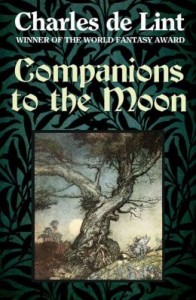 This is a short story that's not connected to Newford–just the story of a woman who thinks her boyfriend is cheating on her, and what she discovers.
This is a short story that's not connected to Newford–just the story of a woman who thinks her boyfriend is cheating on her, and what she discovers.
Of course, this is Charles de Lint, so you never expect what she discovers.
Charles de Lint never fails to amaze me.
He can take 24 pages in that short span create characters and a world, and tell a story that draws you in.
When I read short stories by other authors, I can't help but compare them to Charles de Lint, and I am often disappointed when they fall short.
On the other hand, when I find an author who can replicate this ability, I immediately fall in love.
Cover by Arthur Rackham
Published by Triskell Press
February 2013 | Rating: 9/10
Borderland: Where Magic Meets Rock and Roll (1986) edited by Terri Windling & Mark Alan Arnold
The Borderland anthologies contain stories by some of my favorite authors, in this volume Charles de Lint and Ellen Kushner contributed stories, along with Steven R Boyett and Bellamy Bach.
- Prodigy by Steven R. Boyett
- Gray by Bellamy Bach
- Stick by Charles de Lint
- Charis by Ellen Kushner
I've been a fan of shared world anthologies since Thieves' World, and although Borderlands is nowhere near close to Thieves' World (and some would say that's a good thing) in that there were not the shared characters and story lines that made TW so compelling, there were still four solid stories in this collection. One story was set in the past, soon after the world had been changed by the reappearance of Faerie, the other three stories were set in the present, long after the world had adjusted to the presence of Faerie and Bordertown became whatever it is that it became.
I had high expectations for the last two stories, "Stick" by Charles de Lint, and "Charis" by Ellen Kushner, because I am particularly fond of their writing.
"Stick" seemed very familiar to me, so it's possible I read it in another anthology.
All in all, I'm glad someone was able to find a copy of this book for me, as it is long out of print, because I love reading new stories by Charles de Lint and Ellen Kushner, but it was somewhat dark, and I can see that it might not be for everyone.
Publisher: Tor Books
Rating: 7/10
Snow White, Blood Red (1993) edited by Ellen Datlow & Terri Windling
I often have a hard time putting down interesting books. Which means that if I'm reading a book I real like before bed, I end up staying up past my bed time instead of falling asleep. One solution is to read non-fiction before bed. The other solution is to read short story anthologies. Unfortunately, there are not a lot of high quality anthologies out there. At least, not enough to keep up with the rate at which I can read.
So I decided to go back and reread Ellen Datlow and Terri Windling's fantasy anthology Snow White, Blood Red. This book has a whole bunch of things going for it at once: it's edited by Ellen Datlow and Terri Windling; it's got stories by Neil Gaiman and Charles de Lint; and the stories are retellings or reinventions of folk and fairy tales. Mostly fairy tales in this book.
Plus, a gorgeous cover by Thomas Canty.
For those who are unfamiliar with folk tales and fairy tales, many of the original tales--before they got cleaned up and given to kids--were filled with sex, (in addition to the casual violence of people getting eyes poked out or chopping off bits of feet or being shoved into ovens.)
In other words, these are not stories for children.
The Charles de Lint story, "The Moon is Drowning as I Sleep," is one of my favorites. It's a Sophie Etiole stories, however, like all of Charles de Lint's short stories, can be read and enjoyed without knowing anything of Newford. Another favorite is Neil Gaiman's "Troll Bridge." I love the idea of paths that take us off to hands hidden just beyond our sight. And I love the way that we are manipulated by the main character and the story.
Published by Harper Collins
Rating: 7/10
The Year's Best Fantasy and Horror: Seventh Annual Collection (1994) edited by Ellen Datlow & Terri Windling
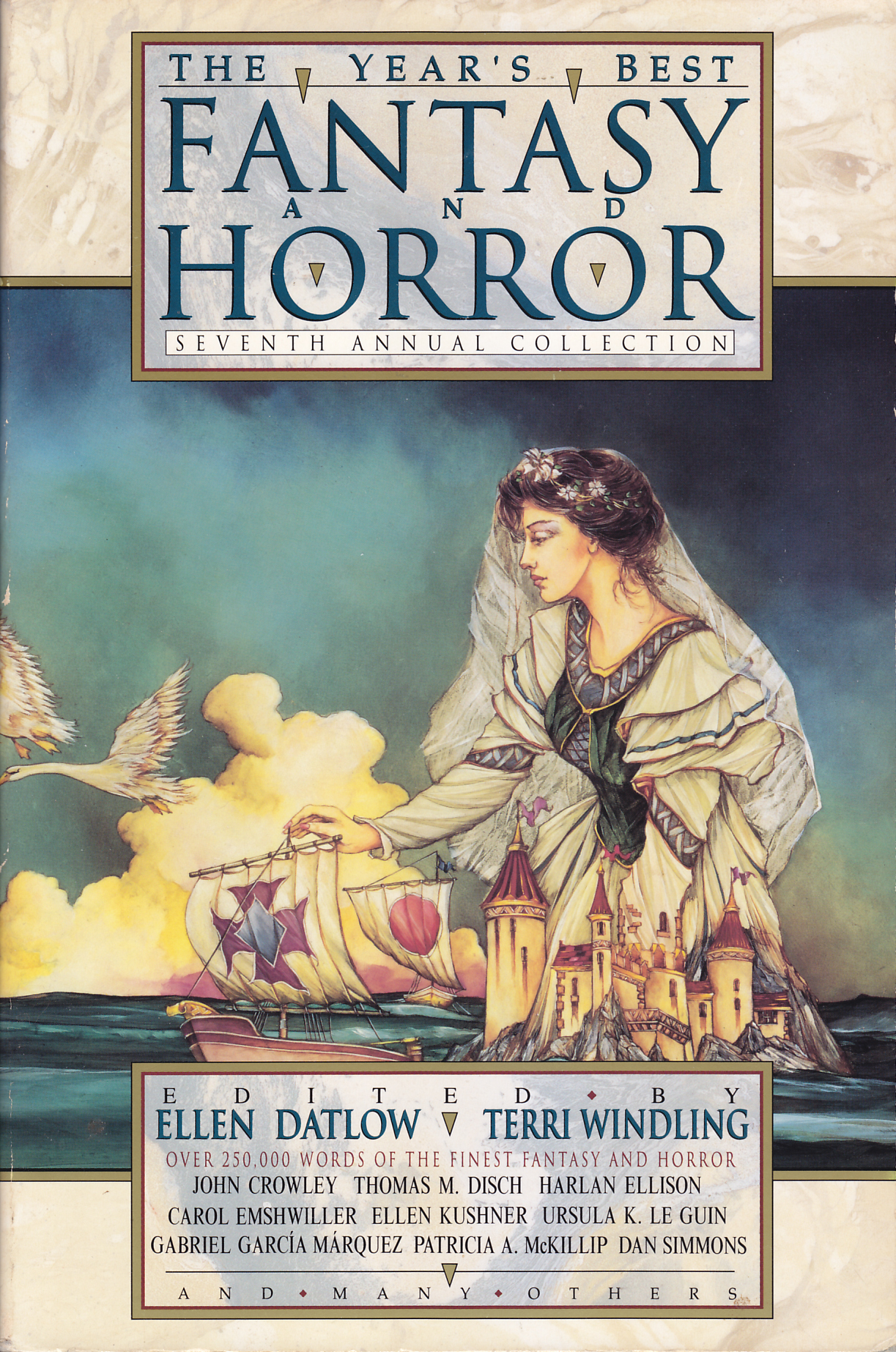 Dead Man's Shoes by Charles de Lint
Dead Man's Shoes by Charles de Lint
Published by St Martins Press
The Year's Best Fantasy & Horror: Eighth Annual Collection (1995) edited by Ellen Datlow & Terri Windling
Coyote Stories by Charles de Lint
Published by St Martins Press
Excalibur (1995) edited Richard Gilliam, Edward E Kramer & Martin H. Greenberg
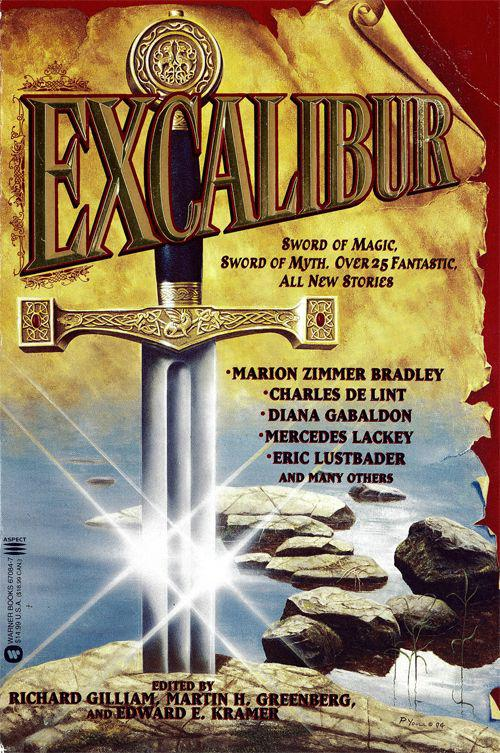
- "Prayer of the Knight of the Sword" by Nancy Holder
- "Echoes of the One Sword" by T. Winter-Damon
- "Grass Dancer" by Owl Goingback
- "All We Know of Heaven" by Peter Crowther
- "Passing" by Charles de Lint
- "Nights of the Round Table" by Lawrence Schimel
- "Here There Be Dragons?" by Marion Zimmer Bradley
- "Goldie, Lox, and the Three Excalibearers" by Esther M. Friesner
- "Silver, Stone, and Steel" by Judith Tarr
- "St. Paul's Churchyard, New Year's Day" by Richard Lee Byers
- "The Other Scabbard" by Brad Linaweaver
- "Hope's Edge" by Daniel H. Scheltema
- "The Waking Dream" by J. M. Morgan
- "The Scout, the Slugger and the Stripper" by Randy Miller
- "The Weapon" by Ardath Mayhar
- "The Sword in the Net" by Brad Strickland
- "Once and Future" by Terry Tappouni
- "Once and Future" by Mercedes Lackey
- "Sword Practice" by Jody Lynn Nye
- "Where Bestowed" by Susan Dexter
- "Demon Sword" by Bill Fawcett
- "Troubled Waters" by Susan Shwartz
- "Literary Cubism Saves the Universe" by Joe Haldeman
- "Duty" by Gary Gygax
- "The Epilogue of the Sword" by Darrell Schweitzer
Publisher: Aspect
The Essential Bordertown (1998) edited by Terri Windling & Delia Sherman
The Essential Bordertown is a collection of short stories set in Bordertown, the land between our world and Faerie. The stories are written with a teenage audiences in mind, with primarily teenage characters, and parts of a "traveler's guide" appearing before each chapter.
Bordertown strikes me as a cross between Sanctuary of Thieves' World and the world created by Charles de Lint. It's the area where faerie and the world of humans meets, and it's a strange place where neither magic or technology works properly, and although there are some places where elves and humans meet and get along, there are roving gangs of elves and humans who rule different parts of town, and woe to the opposite race who wanders into their territory.
- Oak Hill by Patricia A. Mckillip
- Dragon Child by Midori Snyder
- Socks by Delia Sherman
- Half Life by Donnard Sturgis
- Hot Water : A Bordertown Romance by Ellen Kushner
- Arcdia by Michael Korolenko
- Changeling by Elisabeth Kushner
- May This Be Your Last Sorrow by Charles De Lint
- Rag by Caroline Stevermer
- When The Bow Breaks by Steven Brust
- Argentine by Ellen Steiber
- Cover Up My Tracks With Rain by Micole Sudberg
- How Shannaro Tolkinson Lost And Found His Heart by Felicity Savage
Some of my favorite authors contributed to this anthology: Charles de Lint, Steven Brust, Ellen Kushner. I particularly liked Charles de Lint's story "May This Be Your Last Sorrow", but then I think that he has his own magic in that he is able to write the most wonderful short stories.
I would love to read the original Borderland anthologies, however, they're out of print and I'll have to find them used if I want them. But I do recommend The Essential Bordertown to anyone who likes antholgies or any fan of the Charles de Lint.
Published by Harper Collins
Rating: 8/10
Year's Best Fantasy (2001) edited by David G. Hartwell
I'm a sucker for short story collections--I love short stories, and fantasy collections are my favorite, so if I come across a collection, I usually buy it. This has, of course, led to some rather poor choices, such as "The Sorcerer's Academy" and "Earth, Air, Fire, Water", neither of which I've been able to finish. But for the most part collections tend to be good, and help to give me that reading fix, at times when I just can't get involved in a novel.
I'm not certain that I'd agree with the tag at the top of the book "A dazzling treasury of stories," but it is a nice collection. Some stories I liked, other I didn't care as much for, but on the whole it is a good collection.
- The Hunger of the Leaves by Joel Lane
- Greedy Choke Puppy by Nalo Hapkinson
- The Golem by Naomi Kritzer
- The Devil Disinvests by Scott Bradfield
- A Serpent in Eden by Simon Brown and Alison Tokley
- Wrong Dreaming by Kain Massin
- Mom and Dad at the Home Front by Sherwood Smith
- The Fey by Renee Bennett
- GOlden Bell, Seven, and the Marquis of Seng by Richard Parks
- Making a Noise in the WOrld by Charles de Lint
- Magic, Maples, and Maryanne by Robert Sheckley
- The Prophecies at Newfane Asylum by Don Webb
- The Window by Zoran Zivkovic
- And Still She Sleeps by Greg Costikyan
- The Walking Sticks by Gene Wolfe
- Debt of Bones by Terry Goodkind
Published by Harper Voyager
The Green Man: Tales from the Mythic Forest (2002) edited by Ellen Datlow & Terri Windling
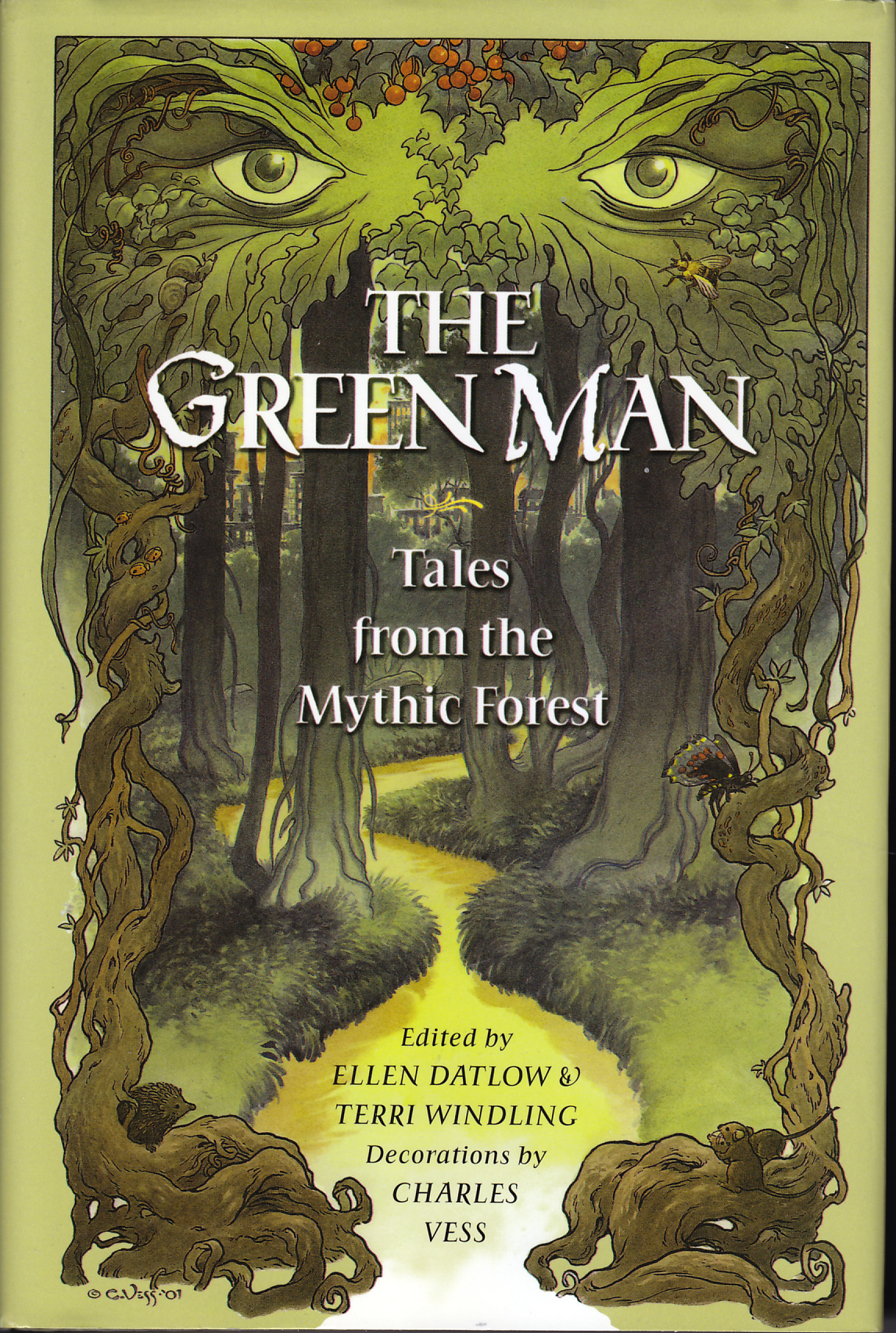 Going Wodwo (poem) by Neil Gaiman
Going Wodwo (poem) by Neil Gaiman- Grand Central Park by Delia Sherman
- Daphne by Michael Cadnum
- Somewhere in My Mind There is a Painting Box by Charles de Lint
- Among the Leaves So Green by Tanith Lee
- Song of the Cailleach Bheur (poem) by Jane Yolen
- Hunter's Moon by Patricia A. McKillip
- Charlie's Away by Midori Snyder
- A World Painted by Birds by Katherine Vaz
- Grounded by Nina Kiriki Hoffman
- Overlooking by Carol Emshwiller
- Fie, Fi, Fo, Fum by Gregory Maguire
- Joshua Tree by Emma Bull
- Ali anugne o chash (the boy who was) by Carolyn Dunn
- Remnants by Kathe Koja
- The Pagodas of Ciboure by M. Shayne Bell
- The Green Man (poem) by Bill Lewis
- The Green Word by Jeffrey Ford
Published by Viking
Year's Best Fantasy 2 (2002) edited by David G. Hartwell
- "The Finder" by Ursula K LeGuin
- "Senator Bilbo" by Andy Duncan
- "Big City Littles" by Charles de Lint
- "What the Tyger Told Her" by Kage Baker
- "In the Shadow of Her Winds" by Ashok Banker
- "The Heart of the Hill" by Marion Zimmer Bradley & Diana L. Paxson
- "Queen" by Gene Wolfe
- "The Black Heart" by Patrick O' Leary
- "On the Wall" by Jo Walton
- "Hell is the Absence of God" by Ted Chiang
- "The Man Who Stole the Moon" by Tanith Lee
- "Firebird by R. Garcia Robertson
- "My Case for Retributive Action" by Thomas Ligotti
- "The Shadow" by Thomas M. Disch
- "Stitchery" by Devon Monk
- "To Others We Know Not Of" by Kate Riedel
- "The Lady of the Winds" by Poul Anderson
- "His Own Back Yard" by James P. Blaylock
- "A Place to Begin" by Richard Parks
- "Nucleon" by David D. Levine
- "My Stolen Sabre" by Uncle River
- "Apologue" by James Morrow
Published by Harper Voyager
Year's Best Fantasy 3 (2003) edited by David G. Hartwell
- "Her Father's Eyes" by Kage Baker
- "Want's Master" by Patricia Bowne
- "October in the Chair" by Neil Gaiman
- "Greaves, This Is Serious" by William Mingin
- "Shift" by Nolo Hopkinson
- "A Book, by Its Cover" by P.D. Cacek
- "Somewhere in My Mind There Is a Painting Box" by Charles de Lint
- "The Pyramid of Amirah" by James Patrick Kelly
- "Our Friend Electricity" by Ron Wolfe
- "Social Dreaming of the Frin" by Ursula K. LeGuin
- "Five British Dinosaurs" by Michael Swanwick
- "The Green Word" by Jeffery Ford
- "The Comedian" by Stephan Chapman
- "The Pagodas of Ciboure" by M. Shayne Bell
- "From the Cradle" by Gene Wolfe
- "Sam" by Donald Barr
- "Persian Eyes" by Tanith Lee
- "Travel Agency" by Ellen Klages
- "A Fable of Savior and Reptile" by Steven Popkes
- "Comrade Grandmother" by Naomi Kritzer
- "Familiar" by China Mieville
- "Honeydark" by Liz Williams "A Prayer for Captain La Hire" by Patrice E. Sarath
- "Origin of the Species" by James Van Pelt
- "Tread Softly" by Brian Stableford
- "How It Ended" by Darrell Schweitzer
- "Cecil Rhodes in Hell" by Michael Swanwick
- "Hide and Seek" by Nicholas Royle
- "Death in Love" by R. Garcia y Robertson
Published by Harper Voyager
The Book of Ballads (2004) by Charles Vess
- Introduction by Terri Windling
- The False Knight On The Road by Neil Gaiman
- King Henry by Jane Yolen
- Thomas the Rhymer by Sharyn McCrumb
- Barbara Allen by Midori Snyder
- The Three Lovers by Lee Smith
- Tam-Lin by Elaine Lee
- The Daemon Lover by Delia Sherman
- Twa Corbies, Sovay by Charles de Lint
- The Galtee Farmer by Jeff Smith
- Alison Gross by Charles Vess
- The Black Fox by Emma Bull
- The Great Selchie Of Sule Skerry by Jane Yolen
- Discography Notes by Ken Roseman
Publisher: Tor Books
Hellboy: Odder Jobs (2004) edited by Christopher Golden & Mike Mignola

- The Brotherhood Of The Gun by Frank Darabont
- From An Enchanter Fleeing by Peter Crowther
- Down In The Flood by Scott Allie
- Newford Spook Squad by Charles De Lint
- Water Music by David J. Schow
- The Vampire Brief by James L. Cambias
- Unfinished Business by Ed Gorman & Richard Dean Starr
- Saint Hellboy by Tom Piccirilli
- Sleepless In Manhattan by Nancy Kilpatrick
- The Wish Hounds by Sharyn Mccrumb
- Act Of Mercy by Thomas E. Sniegoski
- The Thrice-Named Hill by Graham Joyce
- Of Blood, Of Clay by James A. Moore
- A Full And Satisfying Life by Ray Garton
- The Glass Road by Tim Lebbon
- Tasty Teeth by Guillermo Del Toro & Matthew Robbins
Publisher: Dark Horse Books
The Faery Reel: Tales from the Twilight Realm (2004) edited by Ellen Datlow & Terri Windling
Any time I see a fantasy anthology edited by Ellen Datlow and Terri Windling, I'll often as not pick it up, because I know that it's going to be good. Usually very good. This volume however, has the added bonus of poems by both Charles de Lint and Neil Gaiman.
Needless to say I snatched it up--even thought it was in hardback--when I came across it.
These faery tales are based not upon the fairies of Disney but upon the faery of folktales. As they say in the introduction:
In this book about our good neighbors, we've asked a number of our favorite writers to travel into the Twilight Realm (an ancient name for the land of Faerie) and to bring back stories of faeries and the hapless mortals who cross their path. "No butterfly-winged sprites," we pleaded. "Read the old folktales, journey farther afield, find some of the less explored paths through the Realm.
It would be hard for me not to love this book.
- The Boys of Goose Hill by Charles de Lint
- Catnyp by Delia Sherman
- Elvenbrood by Tanith Lee
- Your Garnet Eyes by Katherine Vaz
- Tengu Mountain by Gregory Frost
- The Faery Handbag by Kelly Link
- The Price of Glamour by Steve Berman
- The Night Market by Holly Black
- Never Never by Bruce Glassco
- Screaming for Aferies by Ellen Steiber
- Immersed in Matter by Nina Kiriki Hoffman
- Undine by Patricia A. McKillip
- The Oakthing by Gregory Maguire
- Foxwife by Hiromi Goto
- The Dream Eaters by A. W. Dellamonico
- The Faery Reel by Neil Gaiman
- The Shooter at the Heartrock Waterhole by Bill Congreve
- The Annals of Eelin-OK by Jeffrey Ford
- De La Tierra by Emma Bull
- How to Find Faery by Nan Fry
All in all an excellent anthology. But I hardly expected anything less.
Published by Viking
Rating: 8/10
Faerie Tales (2004) edited by Martin H. Greenberg & Russell Davis
- Introduction (Faerie Tales) by Russell Davis
- Sweet Forget-Me-Not by Charles de Lint
- Yellow Tide Foam by Sarah A. Hoyt
- The September People by Tim Waggoner
- Judgment by Kristine Kathryn Rusch
- Changeling by John Helfers
- He Said, Sidhe Said by Tanya Huff
- A Very Special Relativity by Jim Fiscus
- Witches'- Broom, Apple Soon by Jane Lindskold
- Wyvern by Wen Spencer
- A Piece of Flesh by Adam Stemple
- The Filial Fiddler by Elizabeth Ann Scarborough
- The Stolen Child by Michelle West
Publisher Daw
Emerald Magic (2004) edited by Andrew M. Greely
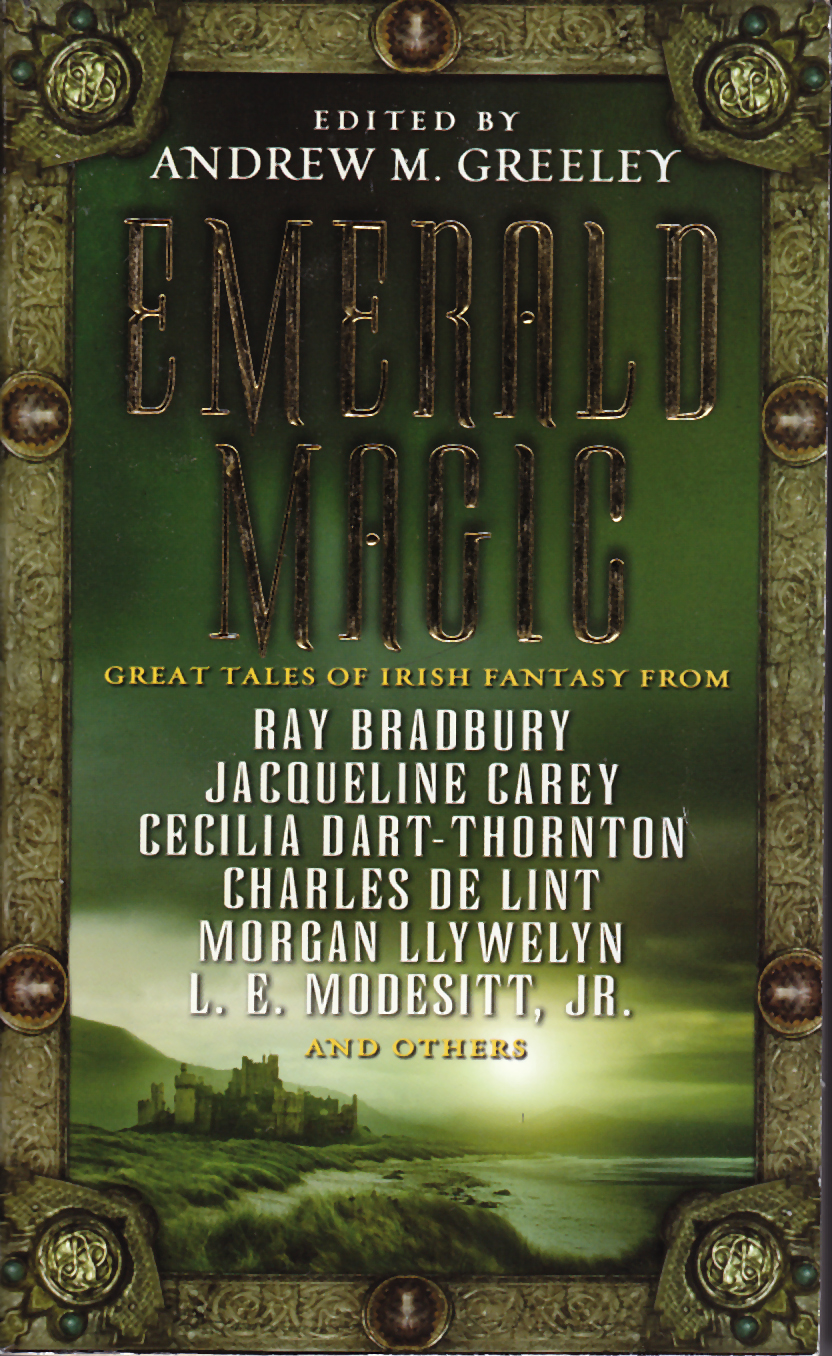
This book first caught my eye because I didn't expect to see Andrew Greeley's name in the fantasy section. Then I looked at the list of authors who wrote in this anthology: Charles de Lint, Diane Duane, Elizabeth Haydon, Morgan Llywelyn, Judith Tarr, Peter Tremayne, Jane Yolen. Even one of those names would have been enough inducement for me to pick up the book--but all those? And more!
Irish mythology, folktales, and fantasy. What more could I want?
Every story I read was excellent, although I did skip L.E. Modesitt Jr's science fiction story (I am rarely in the mood for science fiction.)
- Herself by Diane Duane
- Speir-Bhan by Tanith Lee
- Troubles by Jane Yolen and Adam Stemple
- The Hermit and the Sidhe by Judith Tarr
- The Merrow by Elizabeth Haydon
- The Butter Spirit's Tithe by Charles de Lint
- Banshee by Ray Bardbury
- Peace in Heaven by Andrew Greeley
- The Lady in Grey by Jane Lindskold
- A Drop of Something Special in the Blood by Fred Saberhagen
- For the Blood Is the Life by Peter Tremayne
- Long the Clouds Are Over Me Tonight by Cecilia Dart-Thornton
- The Swan Pilot by L.E. Modesitt, Jr
- The Isle of Women by Jacqueline Carey
- The Cat with No Name by Morgan Llywelyn
I probably would have recognized Charles de Lint's writing without seeing his name on the story. The Butter Spirit's Tithe is set in Newford (another giveaway that this is a de Lint story). Conn O'Neil has accidentally angered a butter spirit, and has to figure out how to remedy the situation, especially when the butter spirit claims that Conn will be his tithe to the devil.
This is an anthology that I will come back and read again, so if you're wondering whether you should make the purchase, my recommendation if definitely YES!
Publisher: Tor
Rating: 8/10
Maiden, Matron, Crone (2005) edited by Martin H. Greenberg & Kerrie Hughes
I try to pick up fantasy anthologies when I see them, since chances are they won't be there the next time I look. I picked up Maiden, Matron, Crone while ago, but saved it to read during the school year, because short story collections are much easier to put down than books.
Some of the stories in this collection were good, some were so-so, and a couple were quite excellent. And there weren't any stories that I absolutely hated, which is always a good thing. The best part of this collection, however, is that if focused on female characters, and for the most part strong female characters.
- A Lingering Scent of Bacon by Brenda Cooper
- A Choice of Ending by Tanya Huff
- Strikes of the Heart by Nina Kiriki Hoffman
- Misery and Woe by Jean Rabe
- In Sight by Charles de Lint
- The Gift by Jody Lynn Nye
- Bearing Life by Devon Monk
- Advice from a Young Witch to an Old Priestess by Rosemary Edghill
- The Three Gems of the Fianna by Fiona Patton
- The Things She Handed Down by Russell Davis
- Seeking Gold by Jane Lindskold
- Opening Her Door by Alexander B. Potter
- The Unicorn Hunt by Michelle West
One of the reasons I picked up this anthology was because it contained a Charles de Lint story. "In Sight" is an evening spent with Ruthie Blue, a middle aged Newford folk musician. I suppose that's one of the nice things about books--you can have middle aged women in your stories, without someone telling you to make them younger and more attractive. I'm hoping that he will write more stories about Ruthie Blue, because I found her a very interesting character.
Publisher Daw
Rating: 6/10
Firebirds Rising (2006) edited by Sharyn November
- Huntress by Tamora Pierce
- Unwrapping by Nina Kiriki Hoffman
- The Real Thing by Alison Goodman
- Little (Grrl) Lost by Charles de Lint
- I'll Give you My Word by Diana Wynn Jones
- In the House of the Seven Librarians by Ellen Klages
- Wintermoon Wish by Sharon Shinn
- The Wizards of Perfil by Kelly Link
- Jack O'Lantern by Patricia A. McKillip
- Quill by Carol Emshwiller
- Blood Roses by Francesca Lia Block
- Hives by Kara Dalkey
- Perception by Alan Dean Foster
- The House on the Planet by Tanith Lee
- Cousins by Pamela Dean
- What Used to be Good Still Is by Emma Bull
This is a collection of fantasy, urban fantasy (minus the boinking) and science fiction. Interestingly, I didn't mind most of the science fiction too much, though they weren't my favorite stories in the collection.
Published by Firebird
Rating: 7/10
The Coyote Road: Trickster Tales (2007) edited by Ellen Datlow & Terri Windling
I love short stories. Aside from collections by Charles de Lint, I best love anthologies by Ellen Datlow & Terri Windling best. Their books are like comfort food, and I save them up for when I'm sick or feeling low.
In the same vein as The Green Man and The Faerie Reel, Datlow and Windling have this time collected stories about tricksters, and they've got some of my favorite authors in this collection: Charles de Lint, Nina Kiriki Hoffman, Ellen Kushner. As usual, they manage to collect stories by some of my favorite story tellers.
- One Odd Shoe by Pat Murphy
- Coyote Woman by Carolyn Dunn
- Wagers of Gold Mountain by Steve Berman
- The Listeners by Nina Kiriki Hoffman
- Realer than You by Christopher Barzak
- The Fiddler of Bayou Teche by Delia Sherman
- A Tale for the Short Days by Richard Bowes
- Friday Night at St. Cecilia's by Ellen Klages
- The Fortune Teller by Patricia A. McKillip
- How Raven Made his Bride by Theodora Goss
- Crow Roads by Charles de Lint
- The Chamber of Music Animals by Katharine Vaz
- Uncle Bob's Visits by Caroline Stevermer
- Uncle Tompa by Midori Snyder
- Cat of the World by Michael Cadnum
- Honored Guest by Ellen Kushner
- Always the Same Story by Elizabeth E. Wein
- The Senorita and the Cactus Thorn by Kim Antieau
- Black Rock Blues by Will Shetterly
- The Constable of Abal by Holly Black
- God Clown by Carol Emshwiller
- The Other Labyrinnth by Jedediah Berry
- The Dreaming Wind by Jeffery Ford
- Kwaku Anansi Walks the World's Web by Jane Yolen
- The Evolution of Trickster Stories Amount the Dogs of North Park after the Change by Kij Johnson
For those who are Charles de Lint fans, "Crow Roads" is not a Newford tale, but an excellent story nevertheless, of a girl dreaming to escape her small, restrictive life. There is little more I can cay, other than as expected, this was an excellent story.
If like short story collections, or trickster tales, then you will want to read The Coyote Road. It has stories from many of my favorite writers, and as with all their collections, I was delighted to discover new authors for whom I'll be on the lookout.
Publisher: Voyager
Rating: 9/10
Vampires: The Recent Undead (2011) edited by Paula Guran
 "The Coldest Girl in Coldtown" by Holly Black
"The Coldest Girl in Coldtown" by Holly Black- "This Is Now" by Michael Marshall Smith
- "Sisters" by Charles de Lint
- "The Screaming" by J.A. Konrath
- "Zen and the Art of Vampirism" by Kelley Armstrong
- "La Vampiresse" by Tanith Lee
- "Dead Man Stalking" by Rachel Caine
- "The Ghost of Leadville" by Jeanne C. Stein
- "Waste Land" by Stephen Dedman
- "Gentleman of the Old School" by Chelsea Quinn Yarbro
- "No Matter Where You Go" by Tanya Huff
- "Outfangthief" by Conrad Williams
- "Dancing with the Star" by Susan Sizemore
- "A Trick of the Dark" by Tina Rath
- "When Gretchen was Human" by Mary Turzillo
- "Conquistador de la Noche" by Carrie Vaughn
- "Endless Night" by Barbara Roden
- "Dahlia Underground" by Charlaine Harris
- "The Belated Burial" by Caitlin R. Kiernan
- "Twilight States" by Albert Cowdrey
- "To the Moment" by Nisi Shawl
- "Castle in the Desert: Anno Dracula 1977? by Kim Newman
- "Vampires in the Lemon Grove" by Karen Russell
- "Vampires Anonymous" by Nancy Kilpatrick
- "The Wide, Carnivorous Sky" by John Langan
This one I have read multiple times, and very much like.
I figure if the people writing the books and making the movies actually do have any firsthand experience with vampires, they're sugar-coating the information so that people don't freak out. If you're going to accept that they exist in the first place, it's much more comforting to believe that you're safe in the daylight, or that a cross or a fistful of garlic will keep them at bay.
About the only thing they do get right is that it takes a vamp to make a vamp. You do have to die from the bite and then rise again three days later. It's as easy as that. It's also the best time to kill a vamp—they're kind of like ragdolls, all loose and muddy-brained, for the first few hours.
Oh, and you do have to invite us into your house. If it's a public place, we can go in the same as anyone else.
What's that? No, that wasn't a slip of the tongue. I'm one, too. So while I like the TV show as much as the next person, and I know it's fiction, blond cheerleader types still make me twitch a little.
You want to read that, don't you?
Published by Prime Books
Rating: 7/10
Happily Ever After (2011) edited by John Klima
Not sure how I missed this when I first came out, but this anthology is full of things I love: authors whose books I love, stories based on folk and fairy tales–lovely!
The only thing I didn't like, is I wish the anthology hadn't ended on such a dark and depressing story.
Mind you, the dark and depressing stories were good–very good–but these tales ran very true to the original stories, with a not insignificant amount of rape and incest and general horribleness. Just like the original tales.
But there's also a good amount of humor as well, and I just wished the collection had ended with one of the funnier stories.
Unsurprisingly, another favorite was "My Life As A Bird" by Charles de Lint. I've read this story previously, but it's still lovely. It's not Jilly's story, but she appears several times, advising Mona, and listening to her (as Jilly does).
Please note, as previously mentioned, the stories have rape and incest and lots and lots of sex in addition to evil stepmothers and other such killers.
There were also a fair number of very dark and very depressing tales that were very good, but that I didn't enjoy at all.
Published by Night Shade Books
Rating: 8/10
Under My Hat: Tales from the Cauldron (2012) edited by Jonathan Strahan
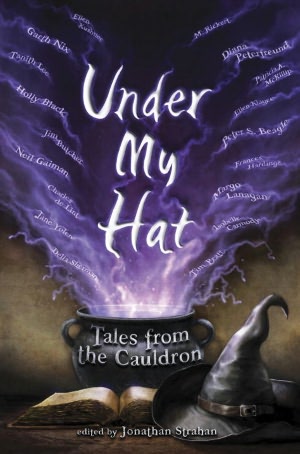
This is a lovely YA anthology, with some amazing stories by some of my favorite authors. I didn't love all the stories, but none of them were bad. The theme is young witches coming of age, but the stories are far greater than that.
- Stray Magic by Diana Peterfreund
- Payment Due by Frances Hardinge
- A Handful of Ashes by Garth Nix
- Little Gods by Holly Black
- Barrio Girls by Charles de Lint
- Felidis by Tanith Lee
- Witch Work by Neil Gaiman (poem)
- The Education of a Witch by Ellen Klages
- The Threefold World by Ellen Kushner
- The Witch in the Wood by Delia Sherman
- Which Witch by Patricia A. McKillip
- The Carved Forest by Tim Pratt
- Burning Castles by M. Rickert
- The Stone Witch by Isobelle Carmody
- Andersen's Witch by Jane Yolen
- B Is for Bigfoot by Jim Butcher
- Great-Grandmother in the Cellar by Peter S. Beagle
- Crow and Caper, Caper and Crow by Margo Lanagan
I love everything Charles de Lint writes.
"Barrio Girls" is no exception. Ruby and Vida want magic, but when they find it, things turn out badly (as they often do) but I adore how things worked out.
Published by Random House
Rating: 9/10
Magic City: Recent Spells (2014) edited by Paula Guran
- "Street Wizard" by Simon R. Green
- "Paranormal Romance" by Christopher Barzak
- "Grand Central Park" by Delia Sherman
- "Spellcaster 2.0" by Jonathan Maberry
- "Wallamelon" by Nisi Shawl
- "-30-" by Caitlín R. Kiernan
- "Seeing Eye" by Patricia Briggs
- "Stone Man" by Nancy Kress
- "In the Stacks" by Scott Lynch
- "A Voice Like a Hole" by Catherynne M. Valente
- "The Arcane Art of Misdirection" by Carrie Vaughn
- "Thief of Precious Things" by A.C. Wise
- "The Land of Heart's Desire" by Holly Black
- "Snake Charmer" by Amanda Downum
- "The Slaughtered Lamb" by Elizabeth Bear
- "The Woman Who Walked with Dogs" by Mary Rosenblum
- "Words" by Angela Slatter
- "Dog Boys" by Charles de Lint
- "Alchemy" by Lucy Sussex
- "Curses" by Jim Butcher
- "De la Tierra" by Emma Bull
- "Stray Magic" by Diana Peterfreund
- "Kabu Kabu" by Nnedi Okorafor
- "Pearlywhite" by Mark Laidlaw and John Shirley
"Dog Boys" by Charles de Lint was one I quite liked, but then I love Charles de Lint's stories. A boy is trying to survive in a new school, in a new town. Depsite trying to keep his head down and himself out of trouble, he gets involved, and steps into trouble far worse than he could have guessed.
All in all this is a marvelous collection, that I highly recommend.
Published by Prime Books
Rating: 8.5/10
Street Magicks (2016) edited by Paula Guran
I believe it took me less than a year to finish this anthology. Hopefully this is a new trend for me.
- "Freewheeling" by Charles de Lint
- "A Year and a Day in Old Theradane" by Scott Lynch
- "Caligo Lane" by Ellen Klages
- "Socks" by Delia Sherman
- "Painted Birds and Shivered Bones" by Kat Howard
- "The Goldfish Pond and Other Stories" by Neil Gaiman
- "One-Eyed Jack and the Suicide King" by Elizabeth Bear
- "Street Worm" by Nisi Shawl
- "A Water Matter" by Jay Lake
- "Last Call" by Jim Butcher
- "Bridle" by Caitlín R. Kiernan
- "The Last Triangle" by Jeffrey Ford
- "Working for the God of the Love of Money" by Kaaron Warren
- "Hello, Moto" by Nnedi Okorafor
- "The Spirit of the Thing: A Nightside Story" by Simon R. Green
- "A Night in Electric Squidland" by Sarah Monette
- "Speechless in Seattle" by Lisa Silvverthorne
- "Palimpsest" by Catherynne M. Valente
- "Ash" by John Shirley
- "In Our Block" by R. A. Lafferty
"Freewheeling" by Charles de Lint this is a story I'd read several times previously, in other anthologies. It is a good story, but sad.
An interesting collection, although there were a lot of stories that were not for me.
Published by Prime Books
Rating: 7/10

